Intro to Psychology 1: Memory, Intelligence, and Personality
1/156
There's no tags or description
Looks like no tags are added yet.
Name | Mastery | Learn | Test | Matching | Spaced |
|---|
No study sessions yet.
157 Terms
memory
the ability to store and retrieve information over time
memory is not photographic or exactly how it happened. There are a lot of factors that contribute to ones memory of a story/situation/place/people/events/etc.
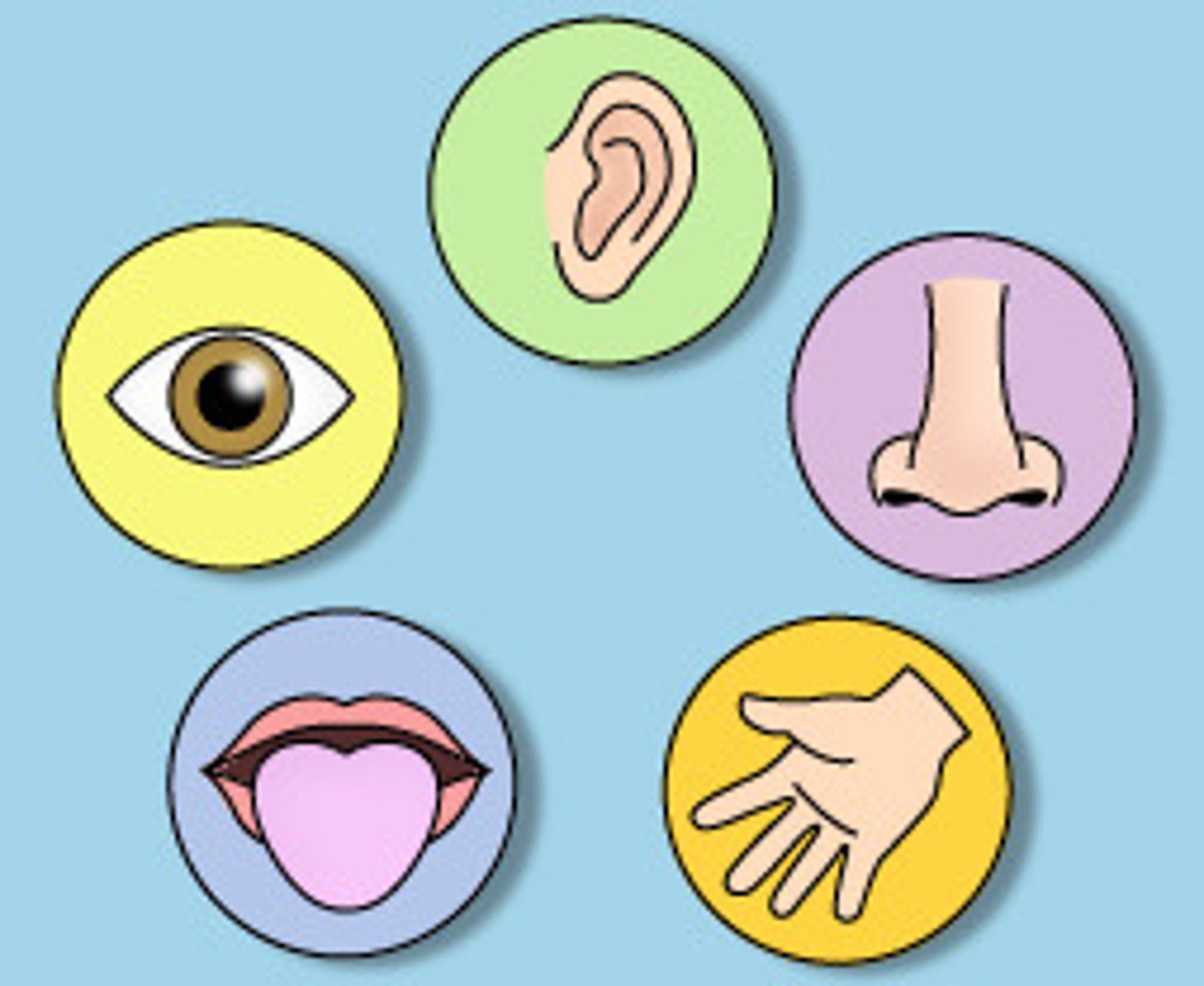
memory process
1. Encoding
2. Storage
3. Retrieval
more specifically:
sensory input (ex. reading a book)---> sensory memory (iconic/echoic memory - remember everything for 1/10th of a second - either image or sound) ----> short term memory (of the thing we paid attention to yet these are NOT YET CODED unless we actively try) ----> long-term memory (encoding and remember for later)
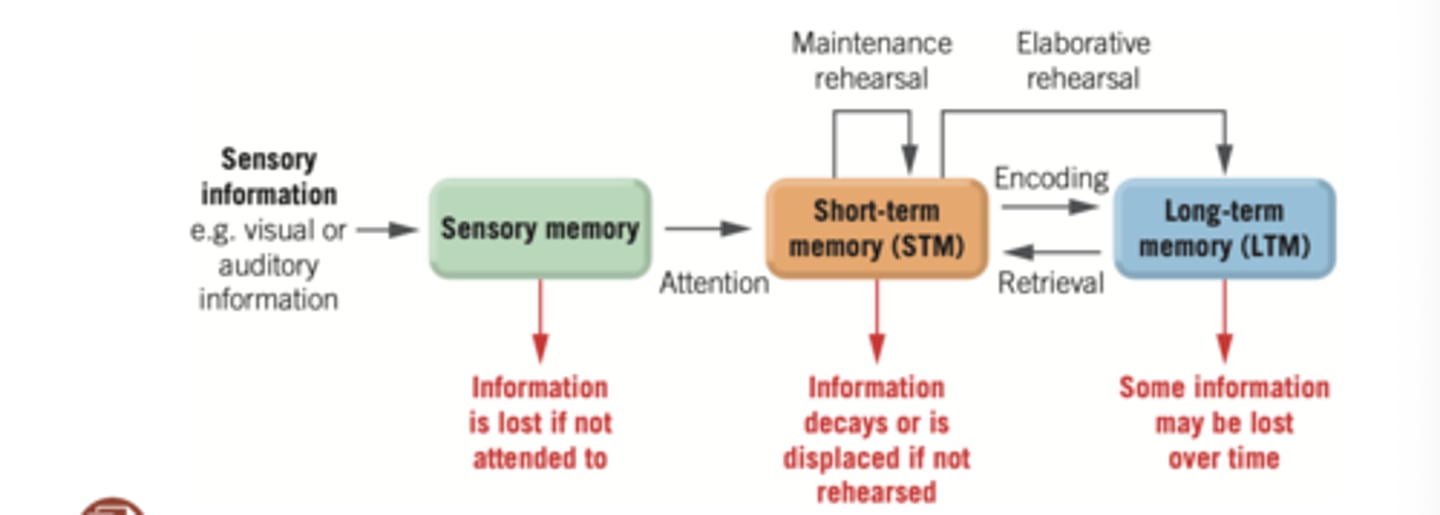
Encoding
the processing of information into the memory system
Storage
the retention of encoded information over time. Memories are held in Synapse - which is the area between nerves
Retrieval
the process of getting information out of memory storage
memory fractioned
Memory (long-term, short-term, and different parts of both) are separated into different parts of the brain
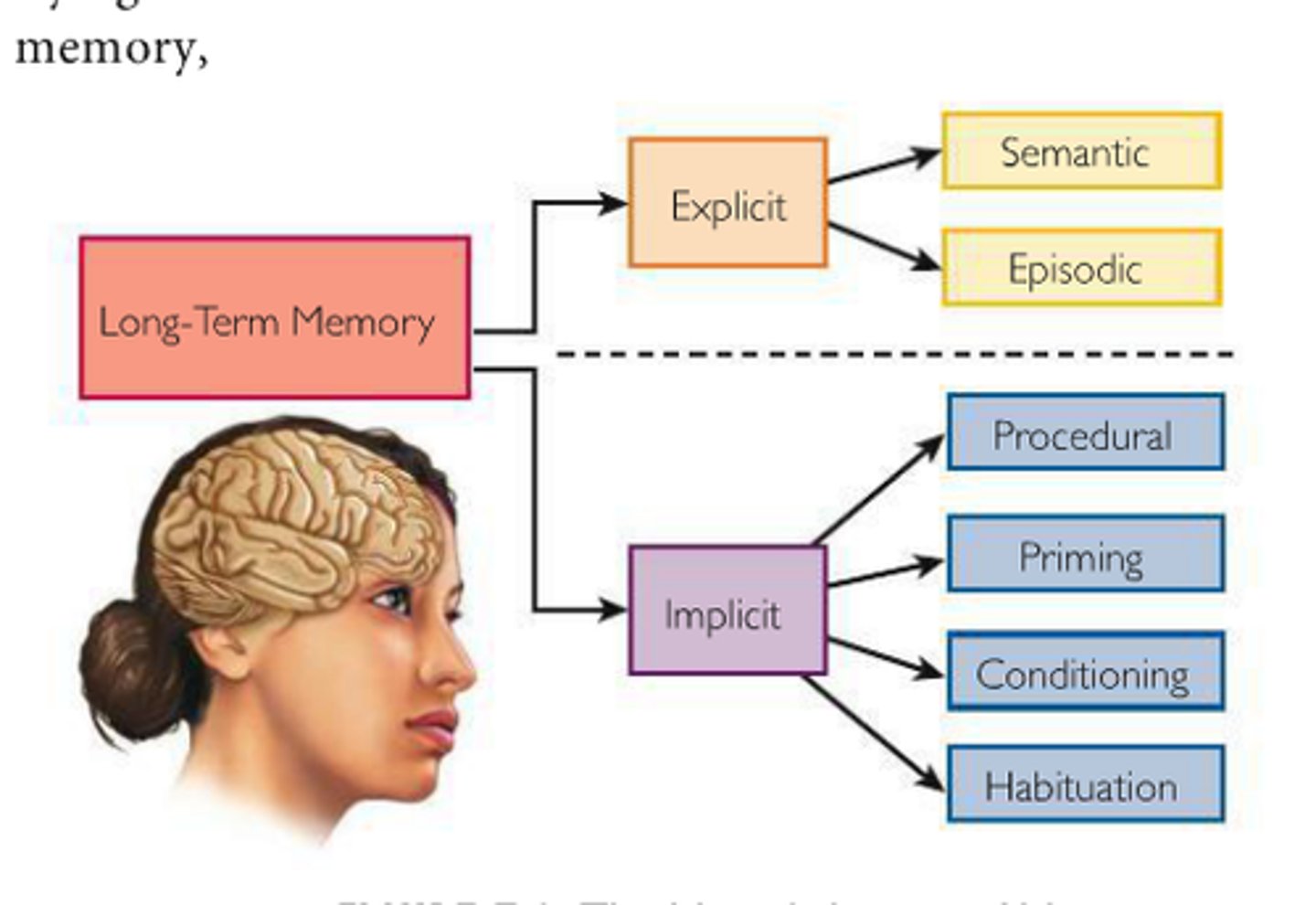
Long term memory
Memory that is relatively permanent in the mind and is stored in the mind and can be retrieved
long term memory characteristics
1. unlimited capacity
2. unlimited duration
3. explicit (declarative)
4. implicit (non declarative)
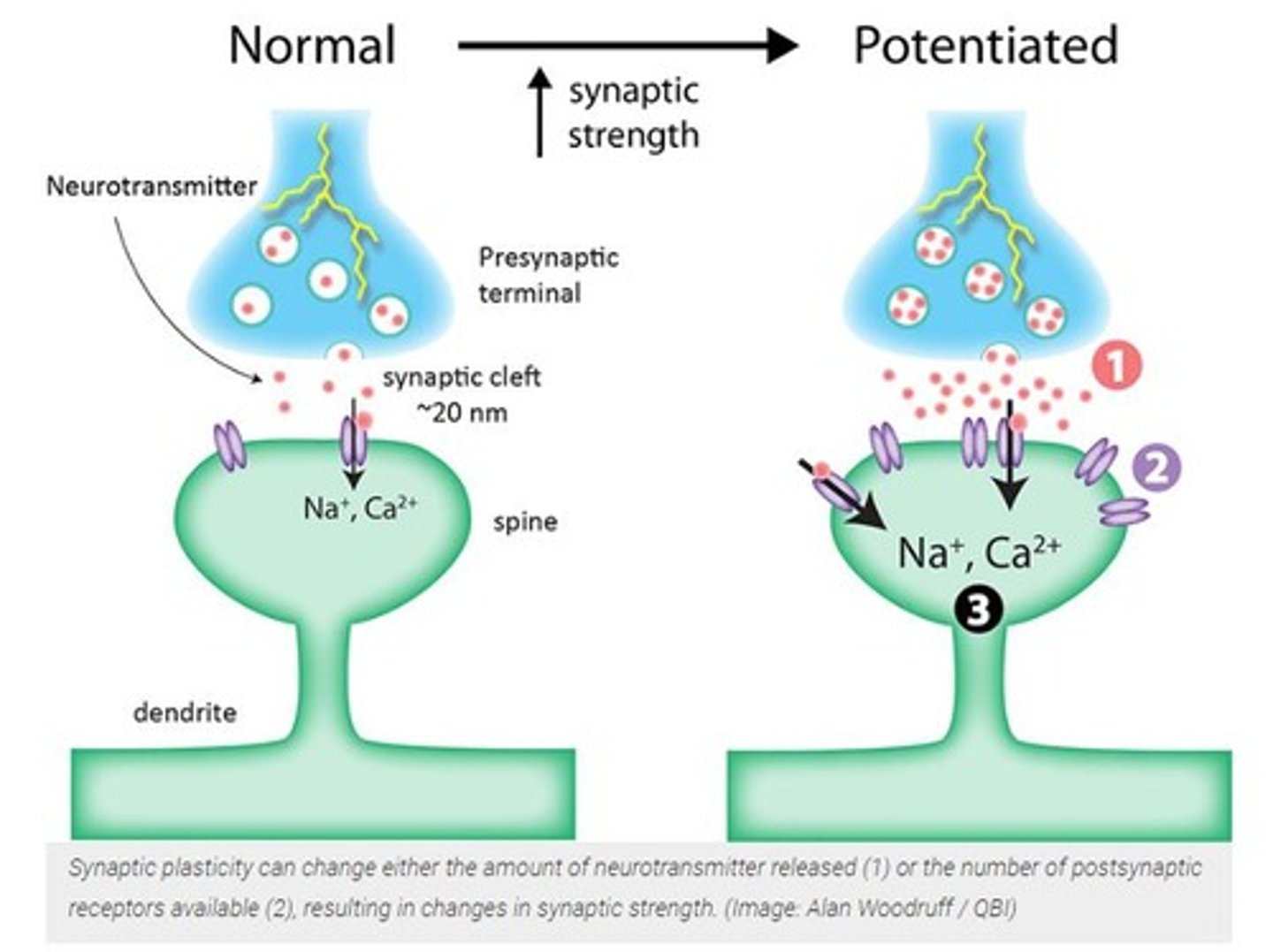
explicit memory
memory of facts and experiences that one can consciously know and "declare"
THEY TALK ABOUT IT
under explicit there is..
1. semantic
2. episodic
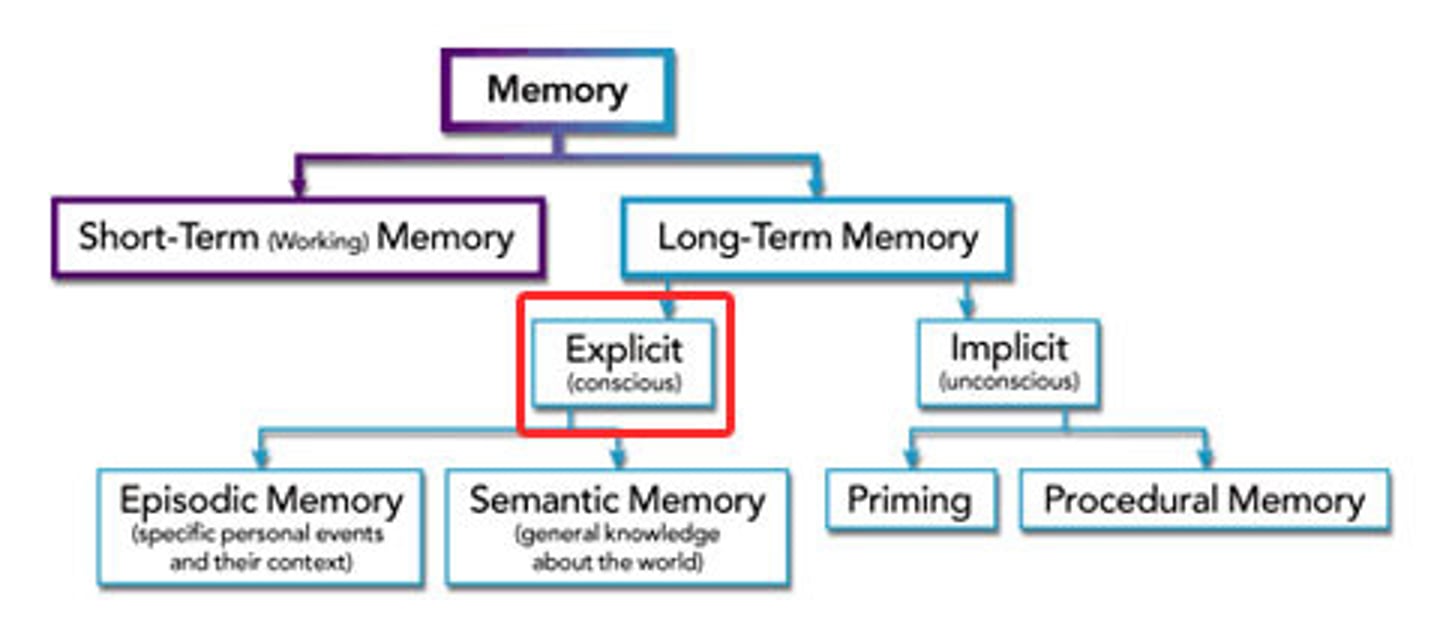
semantic memory
knowledge and facts that are not opinions but rather statements
things you SAY
this is KNOWING!
ex. the capital of France is Paris
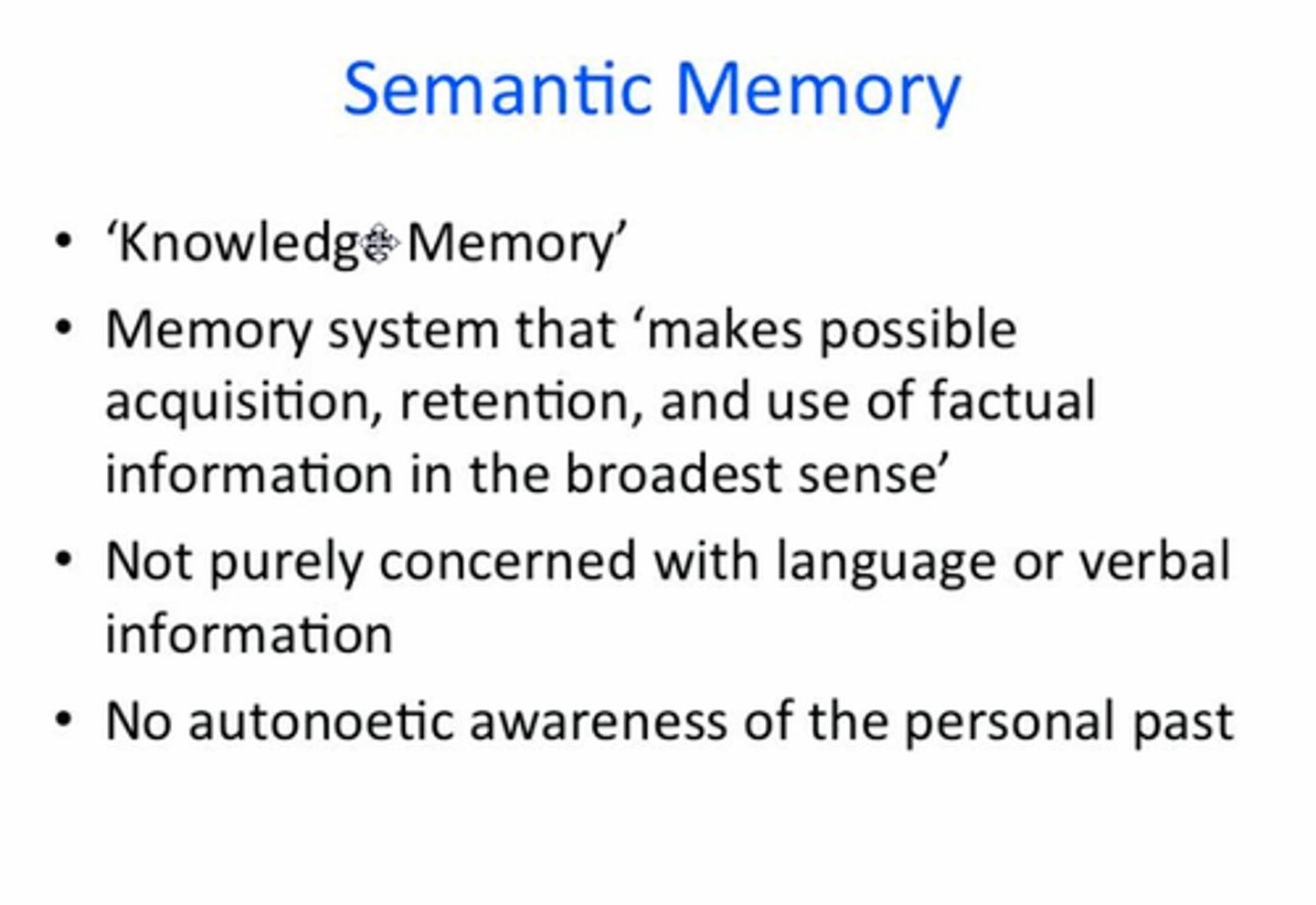
episodic memory
this is emotional memory, memory that is tied to stories that you TALK about and REMEMBER. They have EMOTION ATTACH TO IT
THIS IS REMEMBERING!
ex. your first birthday party
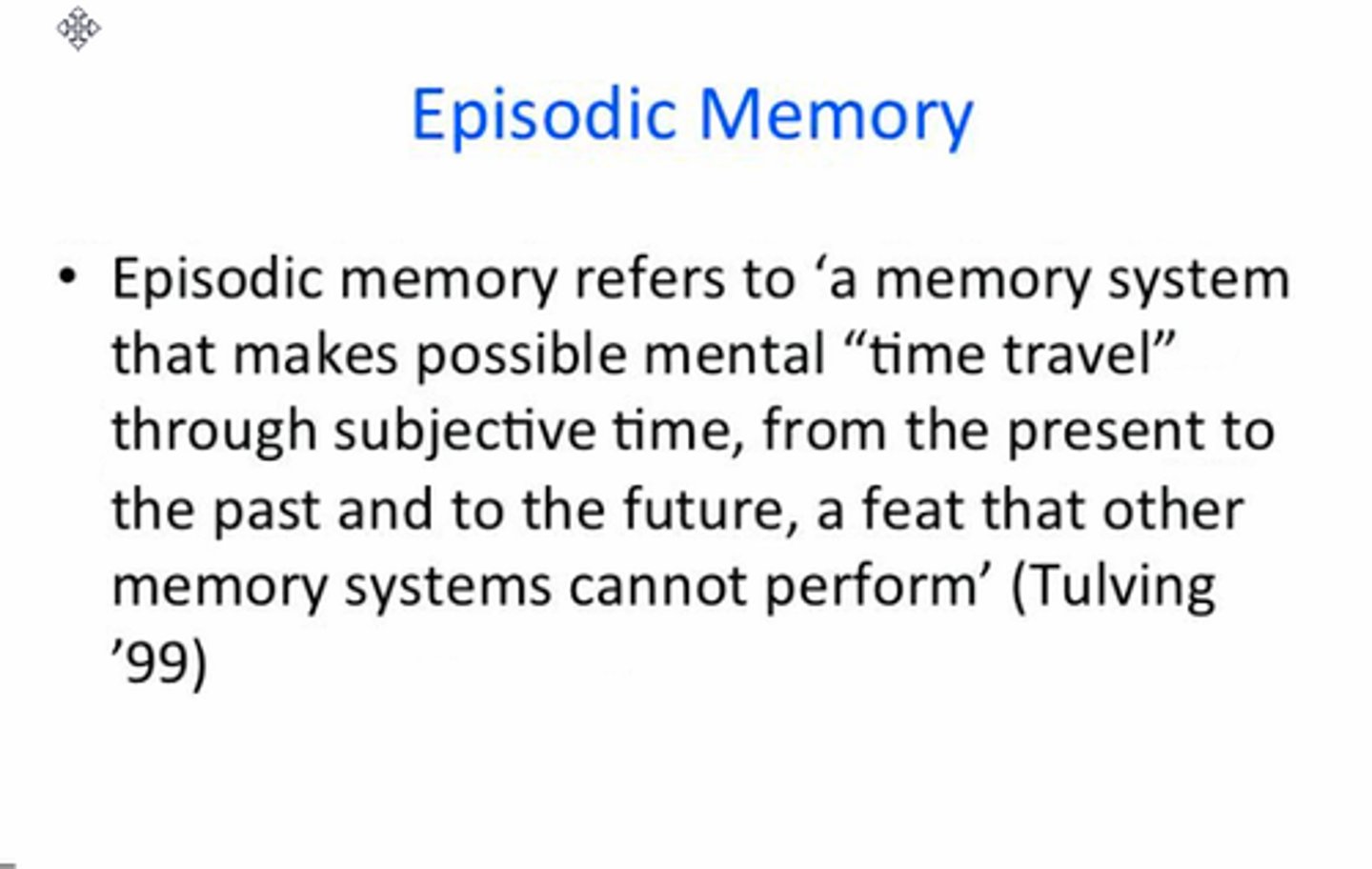
implicit memory
retention independent of conscious recollection
memory that you don't tell, but show
this includes..
1. procedural memory
2. priming
3. conditioning
(ex. riding a bike, talking, etc.)
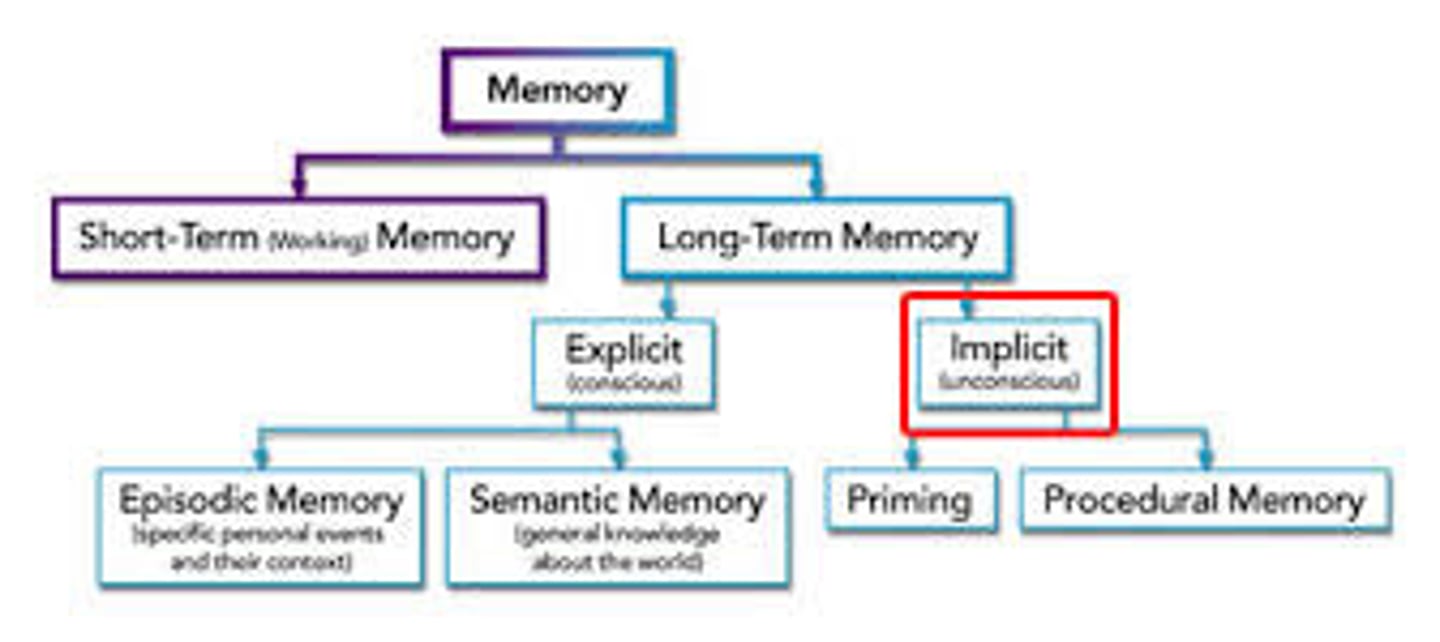
procedural memory
A type of long-term memory of how to perform different actions and skills. Essentially, it is the memory of how to do certain things like motor skills
ex. riding a bike, drawing

priming memory
unconscious memory processing in which prior exposure to stimulus items may interfere with what you say/think/do
priming - an enhanced ability to think of a stimulus, such as a word or object, as a result of a recent exposure to the stimulus
(ex. in an experiment the word in all caps STAMPS is shown and at the end they ask the first word to come to mind when you think of a word that starts with ST you are more likely to say stamp without even realizing you had seen it before)
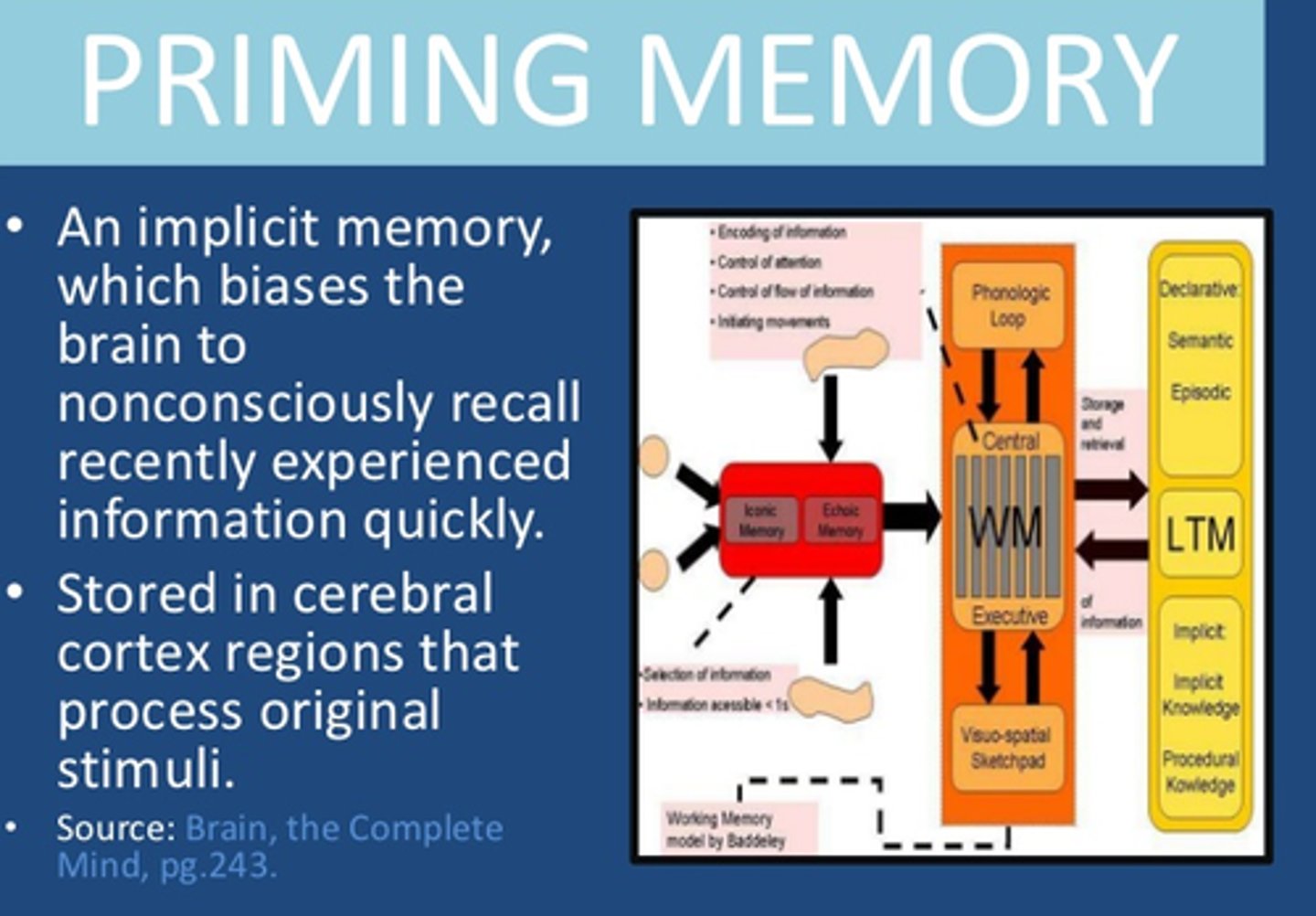
conditioning memory
o associate neutral stimuli (such as a sound or a light) with another stimulus (such as food), which creates a naturally occurring response, such as enjoyment or salivation.
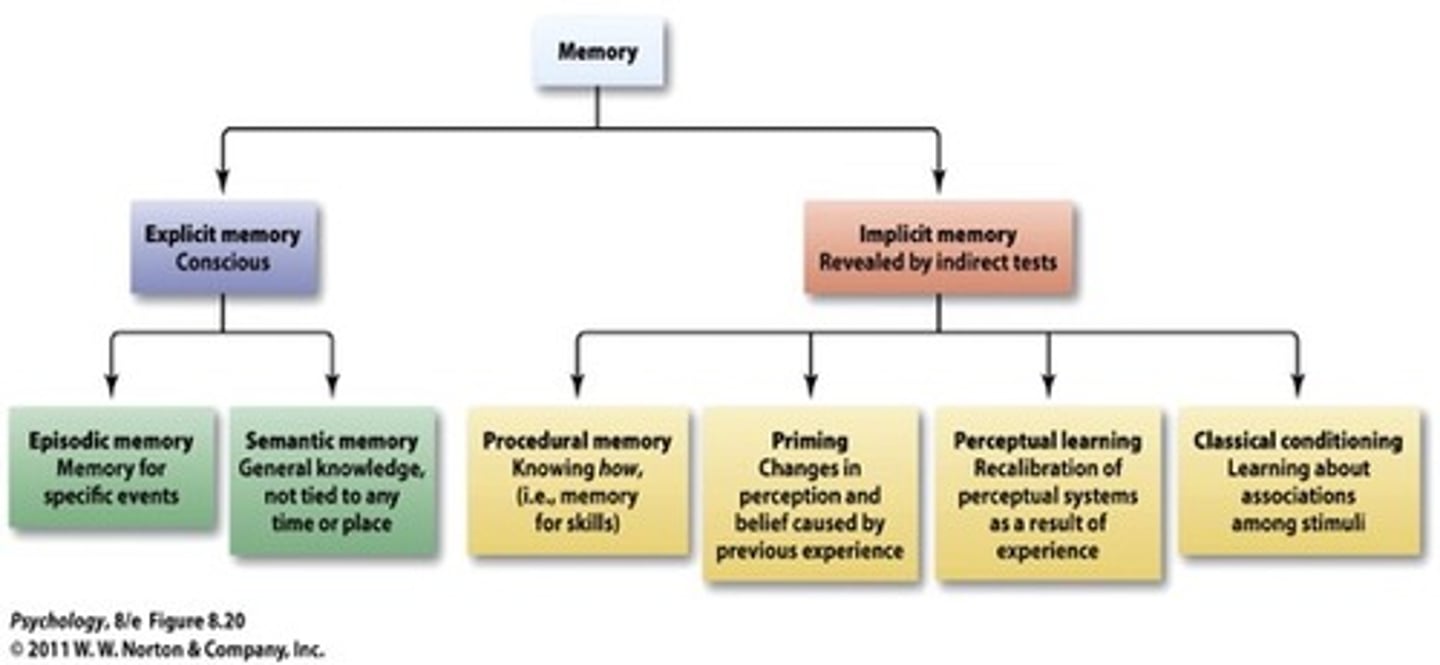
implicit vs. explicit memory
explicit memory: conscious, may be visualized, may be verbally described
implicit memory: usually physical--skills, motor movement., independent of conscious recollection and is non-declarative
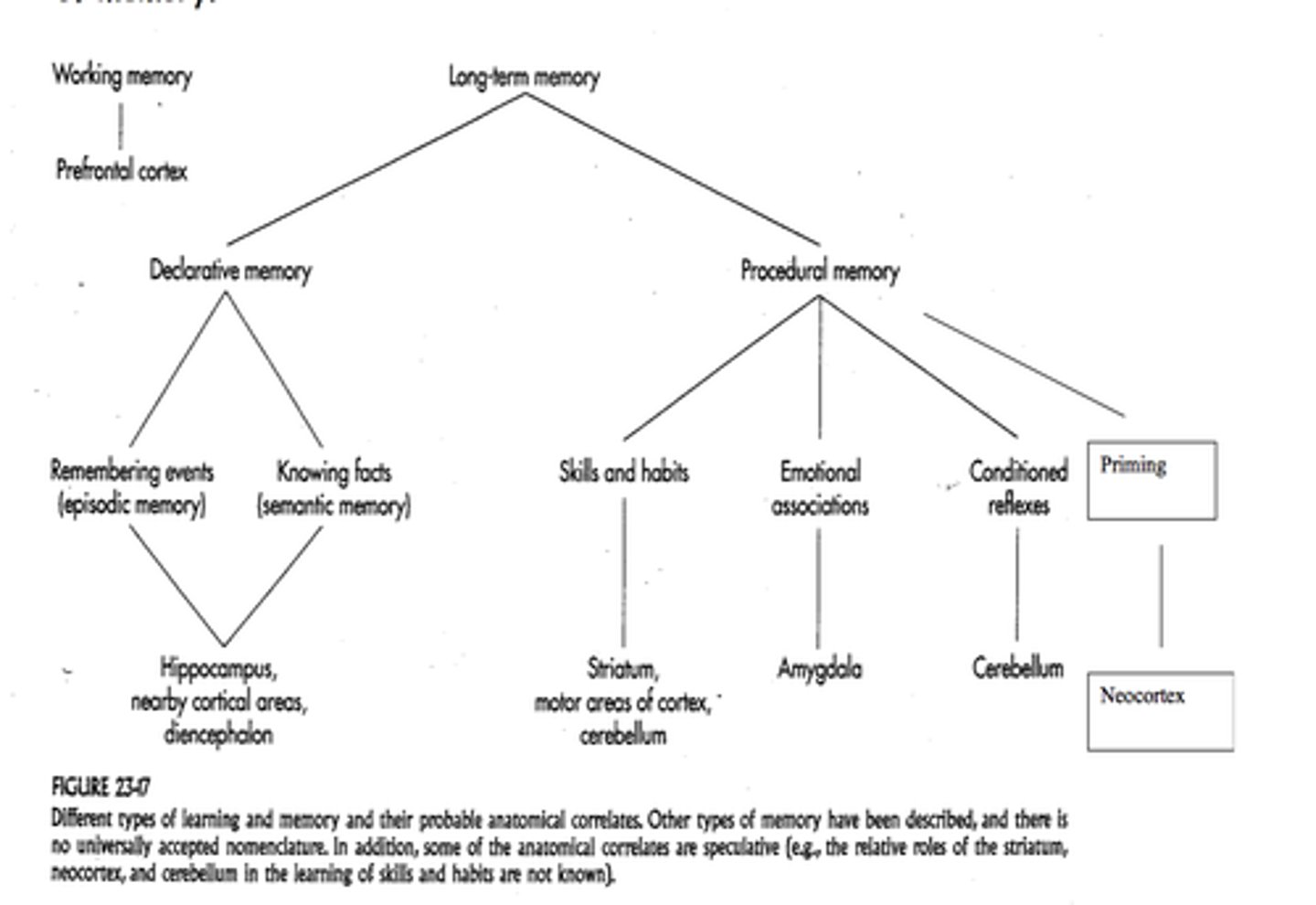
short term memory
also known as the working memory which holds information for a short amount of time (a few seconds at most) yet can extend by repeating over and over into your head
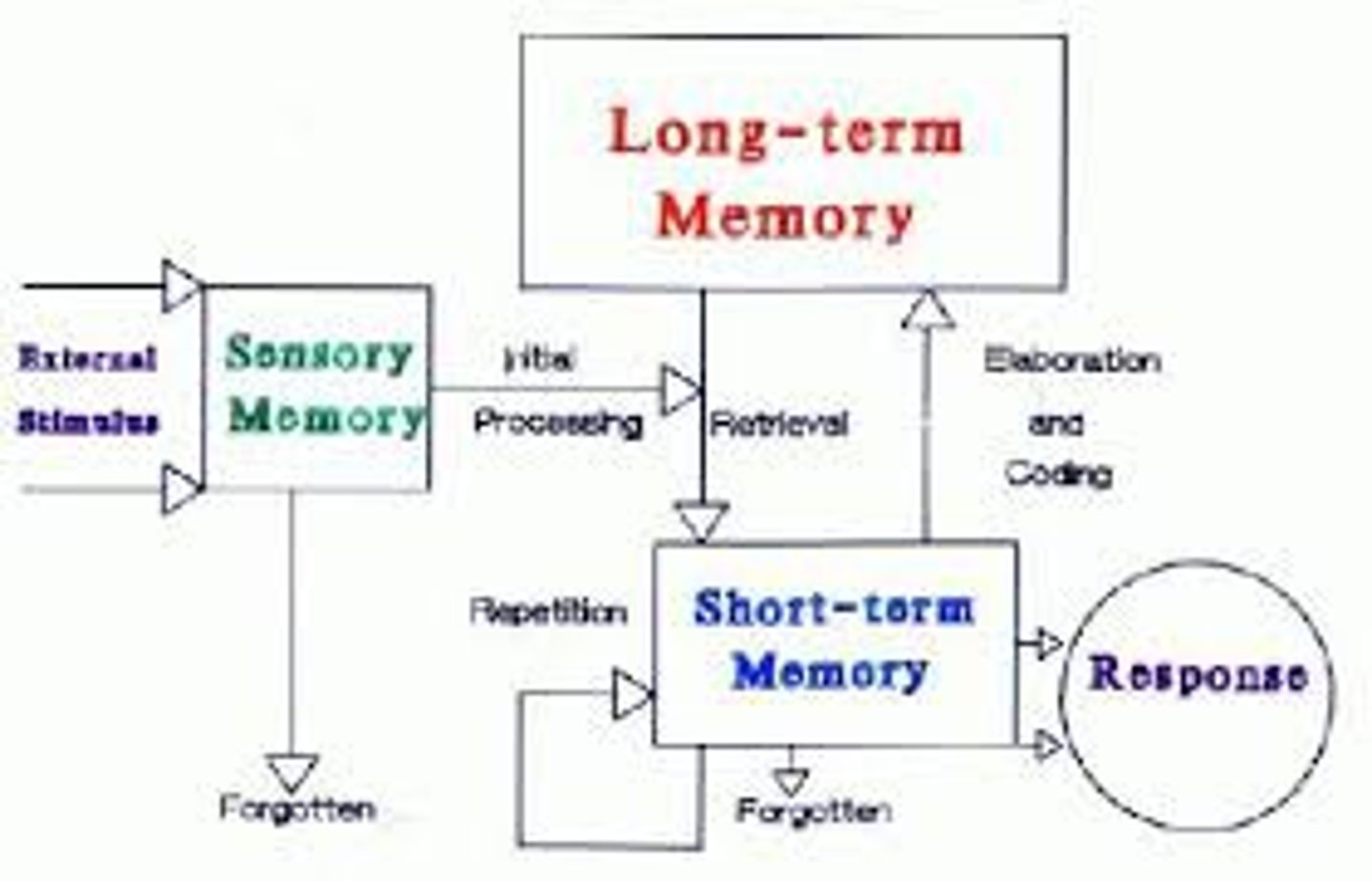
characteristics of short term memory
1. limited duration
2. limited capacity - usually can remember 2 digits and 7 words..unless chunking
3. can extend short term memory by repeating it
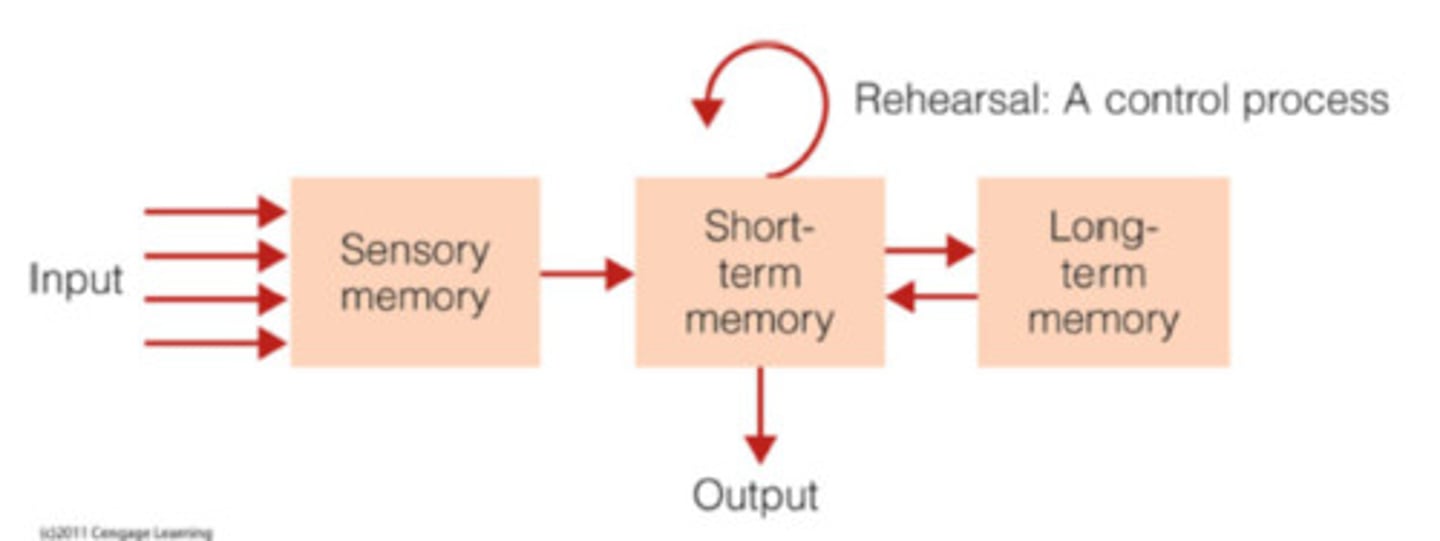
chunking memory
combining small pieces of info into large chunks that are easily held in short term memory
ex. ITVBBCSKY is easier to remember than VSBYIBCKT
anterograde amnesia
an inability to form new memories

retrograde amnesia
an inability to retrieve information from one's past
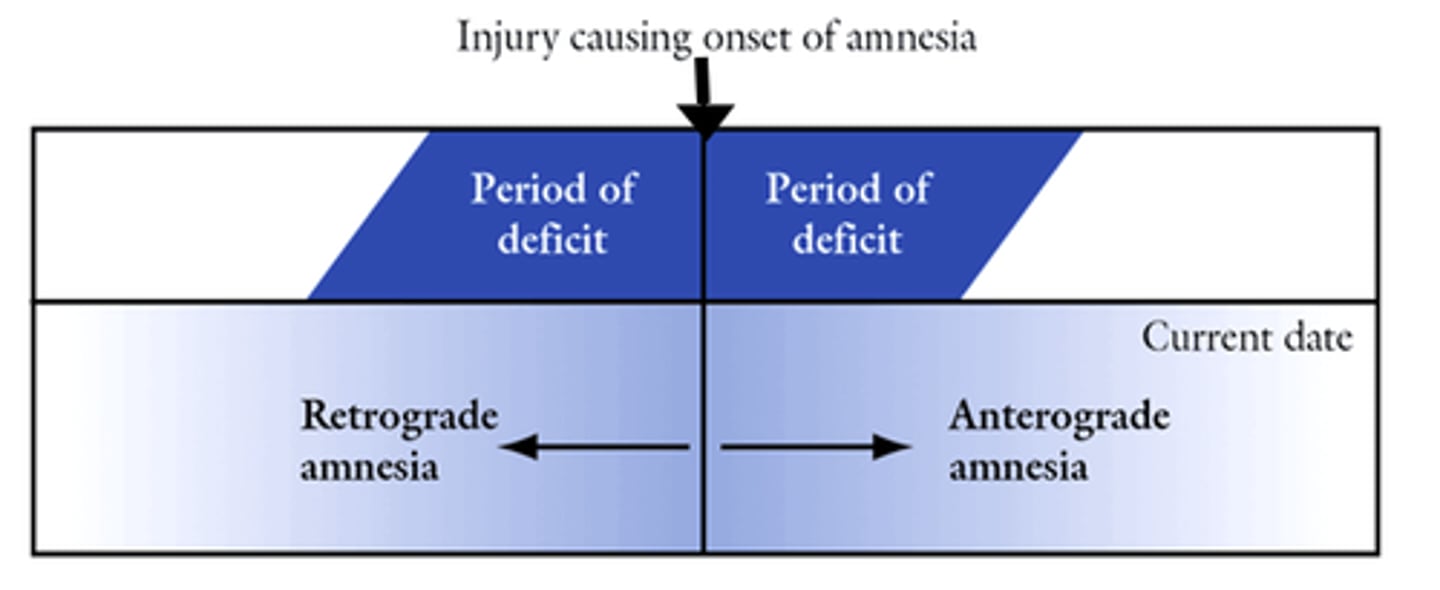
short vs long term memory
short: holds few items briefly
long: relatively permanent and limitless storehouse of memory system
amnesia patients with short term memory loss but long term memory cannot remember digits they heard a couple seconds ago but can remember events that have happened as those are encoded into long-term memories and stored in the brain
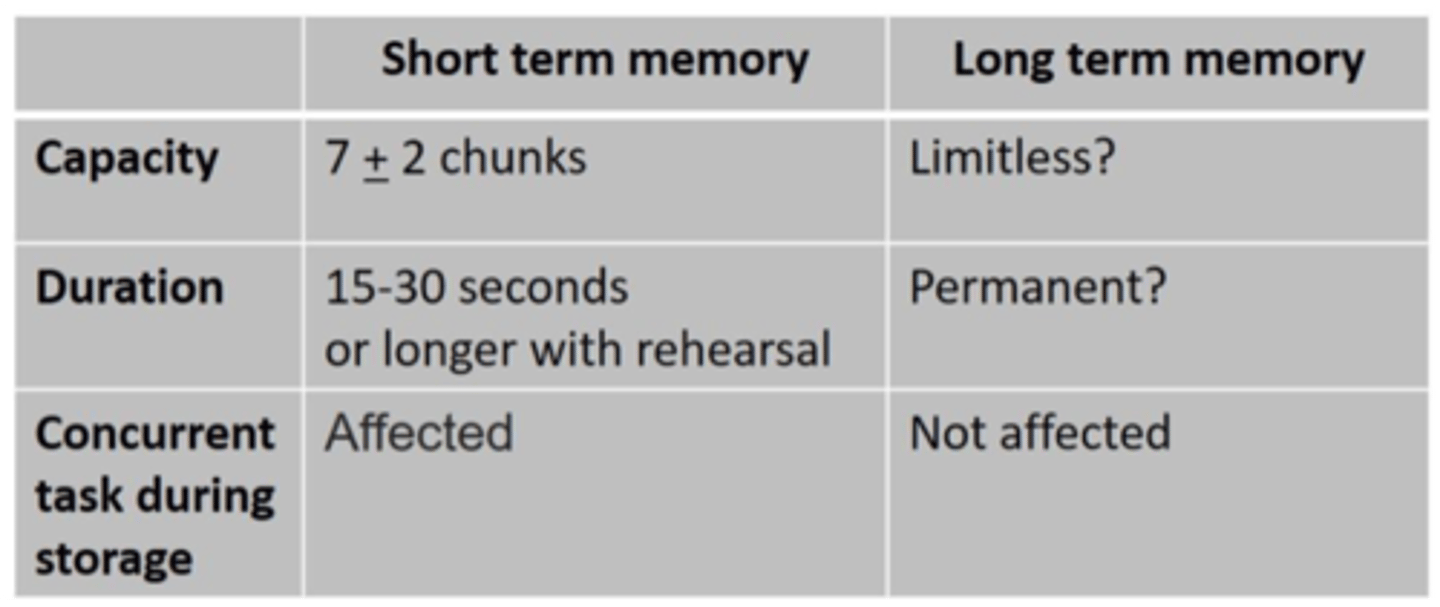
iconic memory/sensory memory/echoic memory
A photographic or picture-image memory lasting no more than a few tenths of a second..where you can see the whole entire image yet may not be able to report/have cognitive for all of it
this is also Echoic memory is a fast-decaying store of auditory information.
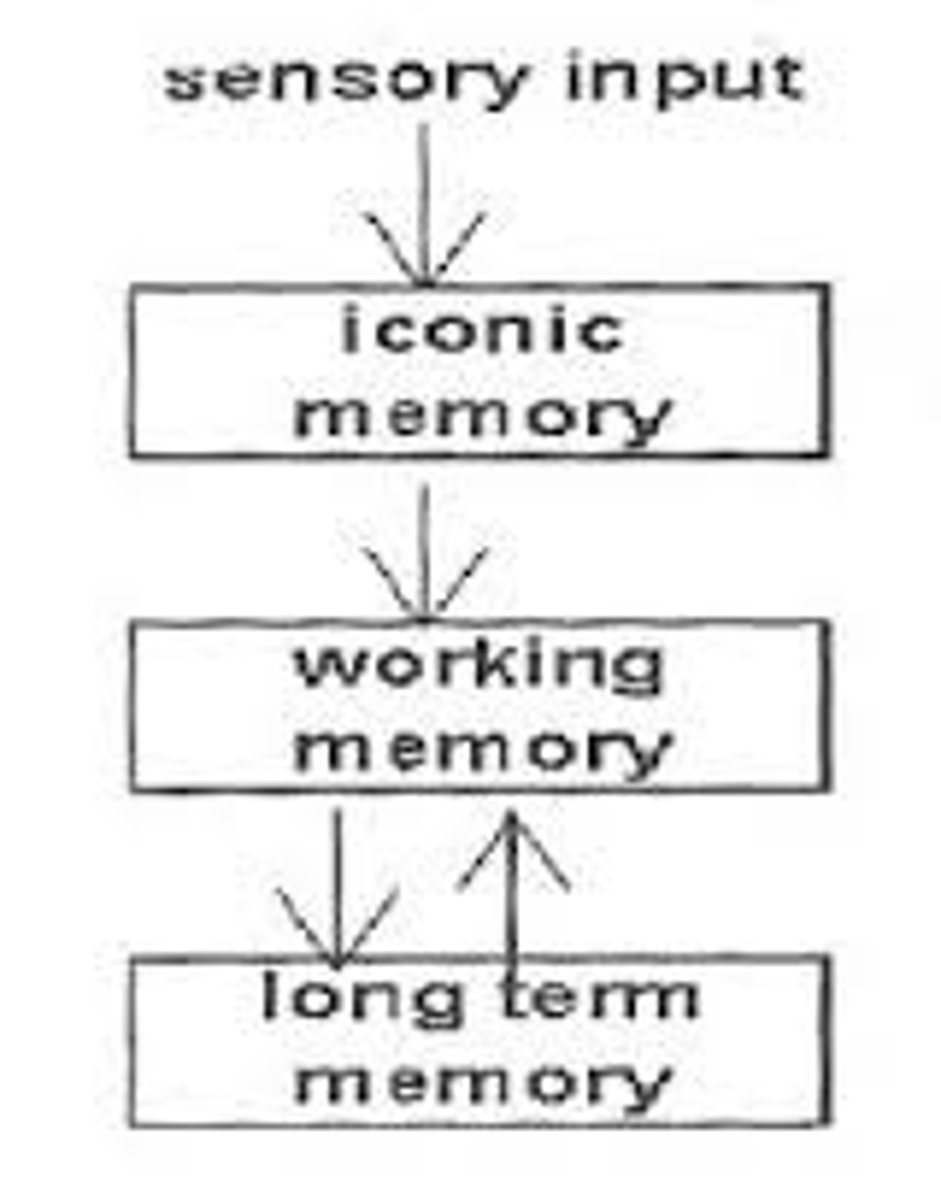
why do people remember the middle last?
This is because when you are trying to remembering things/events..
the first words people can tend to remember cause it goes into longterm
the last people remember cause they repeat it in their heads
the middle disappears

mindbugs
ingrained habits of thought that lead to errors in how we perceive, remember, reason, and make decisions
ex. blocking
blocking - a failure to retrieve information that is available in memory even though you are trying to produce it.
working memory
a newer understanding of short-term memory that focuses on conscious, active processing of incoming auditory and visual-spatial information
visuosptail briefly stores visual and spatial information, then the phonological loop briefly encodes in a short-term store/rehearsal system
No, working memory and iconic memory are distinct forms of memory, with iconic memory being a high-capacity, very brief sensory memory of a visual stimulus, while working memory has a much more limited capacity but can hold information for a longer duration to be used for cognitive tasks. Iconic memory acts as a temporary storage of raw visual "icons" before they are either forgotten or transferred to longer-lasting visual working memory, which stores more integrated representations
ex. hear "sum of 15 +5+
phonological/visuospatial - representation of sound/sight
episodic buffer - remember addition
central executive - rules put into buffer from long-term memory to do problem
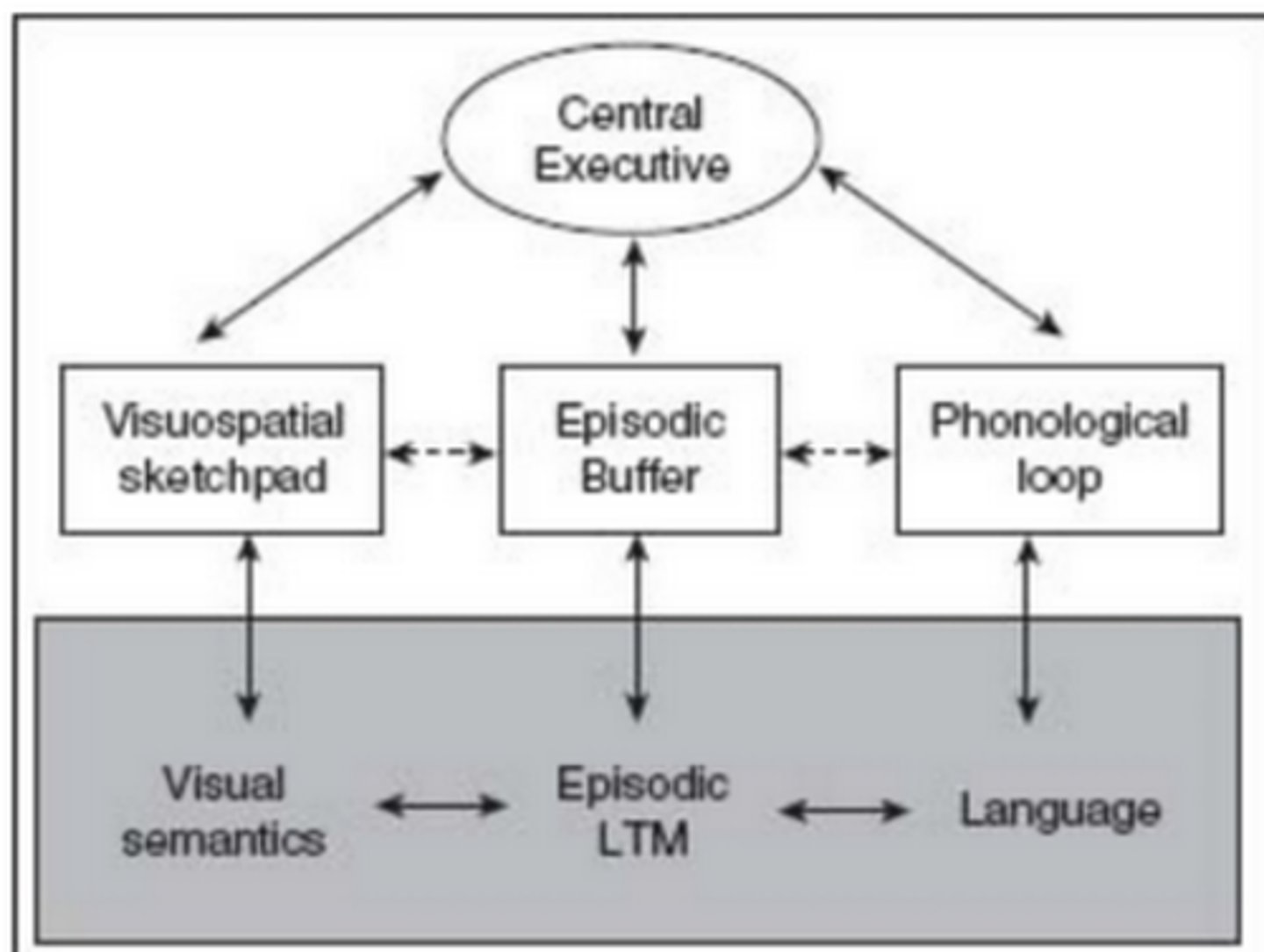
seven sins of memory
transience - forgetting over time absentmindedness - lapses in attention that result in forgetting blocking - temporary inability to retrieve information memory misattribution - confusing the source of a memory suggestibility - incorporating misleading information into a memory bias - the influence of present knowledge, beliefs and feelings on recollections of the past persistence - recalling unwanted memories we would prefer to forget
episodic buffer
A component of working memory where information in working memory interacts with information in long term memory (eg. relating information you are processing to a previous memory)
central executive
The part of working memory that is responsible for monitoring and directing attention and other mental resources.
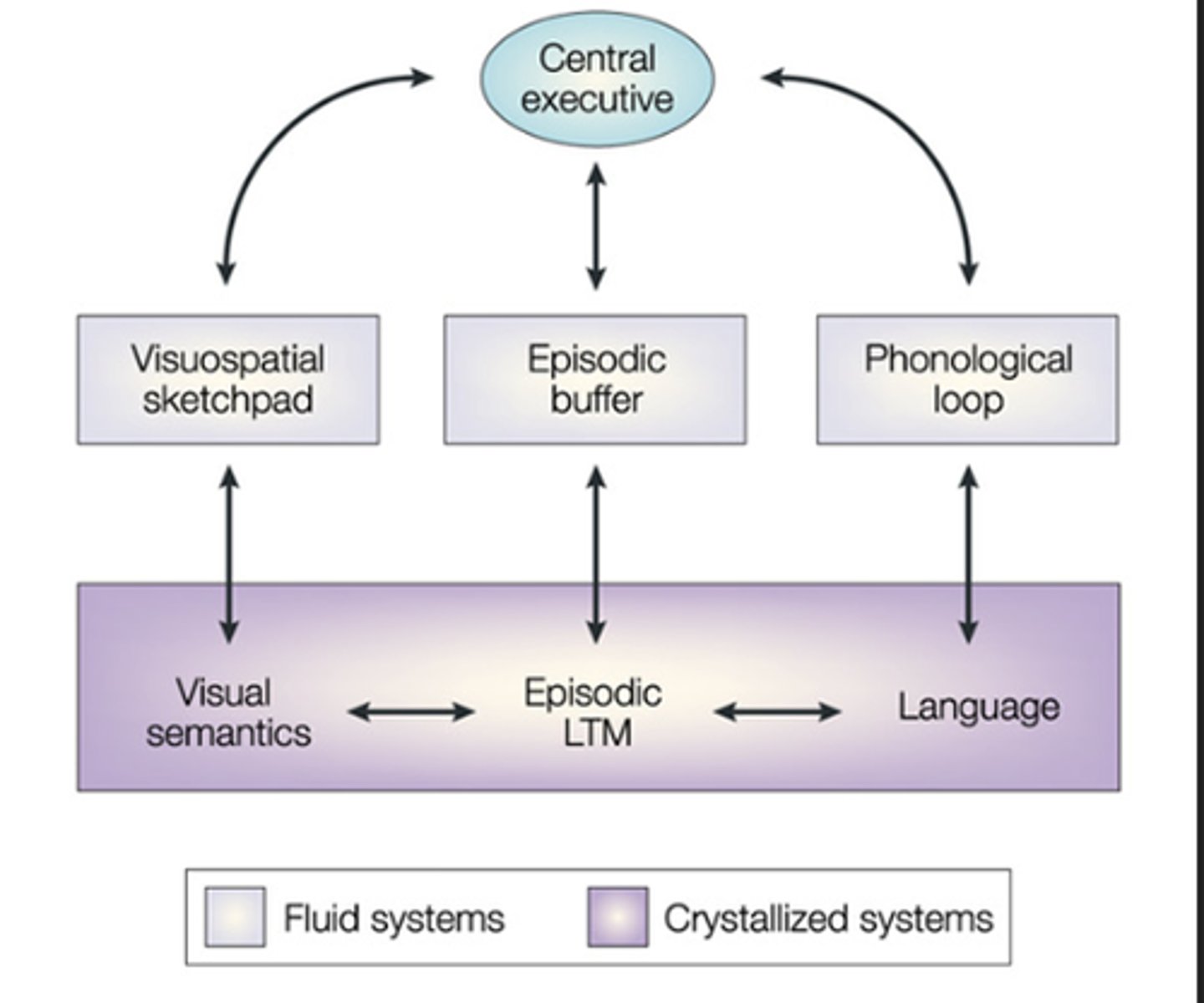
visuo spatial
stores visual and spatial information
Capacity is 3-4 objects
Visual cache (visual data)
Inner scribe (arrangement of objects in visual field)
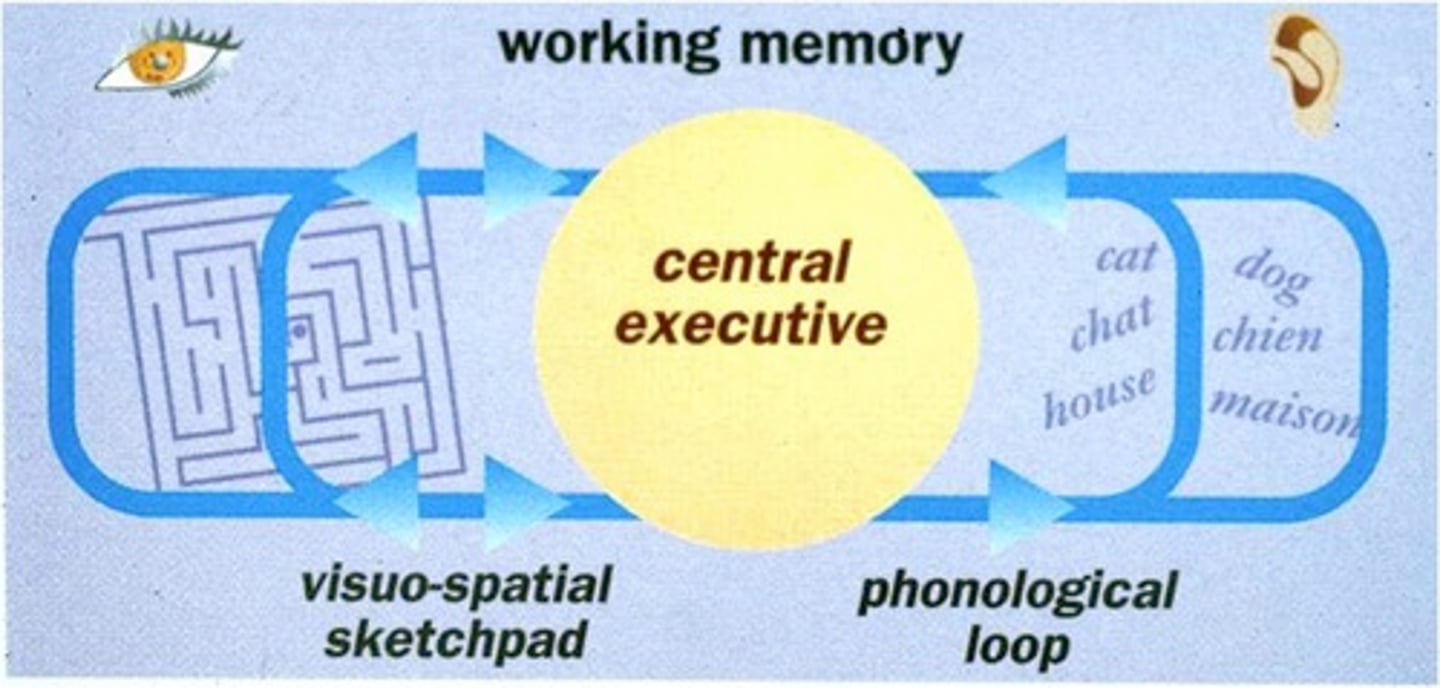
phonological
the study of the sound system of a given language and the analysis and classification of its phonemes
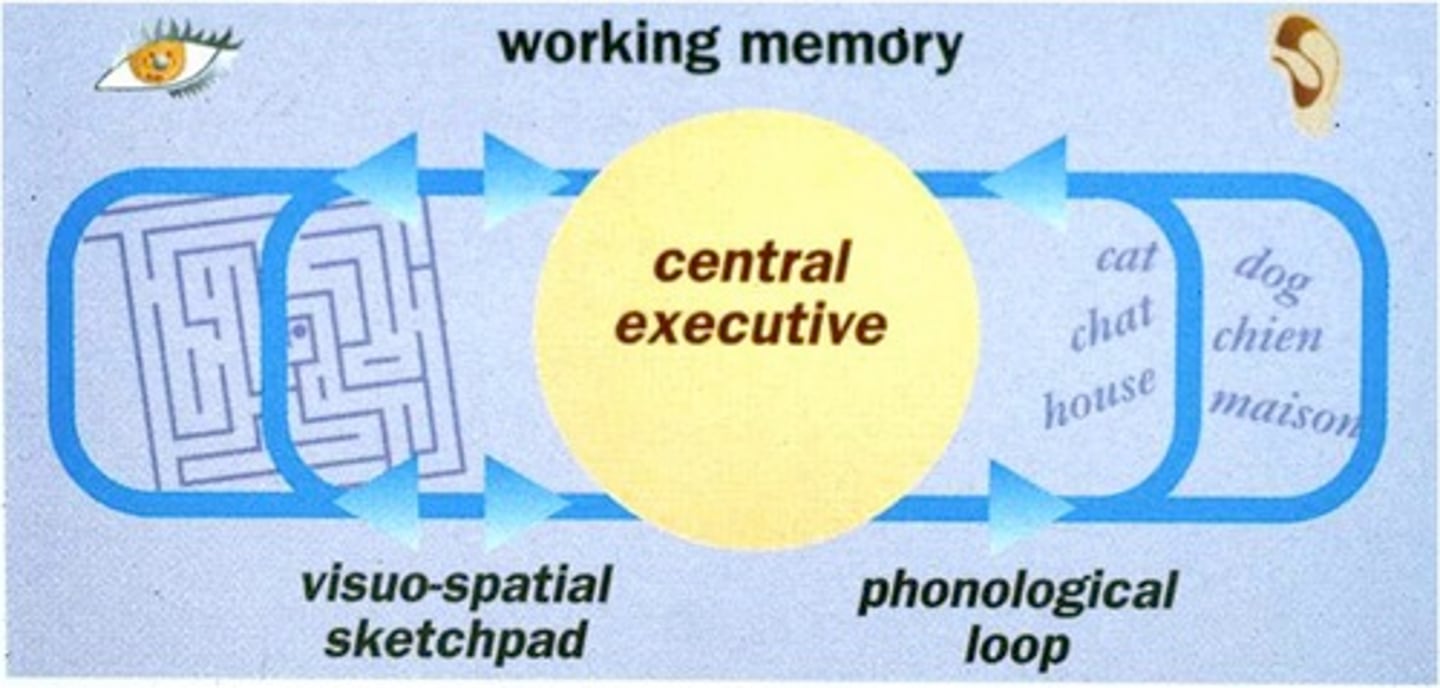
how do we store memories?
synaptic consolidation
OR
systemic consolidation
synaptic consolidation
What it is:The initial stabilization of a memory trace at the synaptic level.
Timescale:Happens within minutes to hours after learning.
Where it happens:Occurs at the synapses—the connections between neurons—especially in the hippocampus.
Biological mechanisms:Involves long-term potentiation (LTP), changes in synaptic strength, and the formation of new proteins.
Purpose:Helps lock in the memory at the cellular level so it’s not easily lost in the short term.
more long-term facts
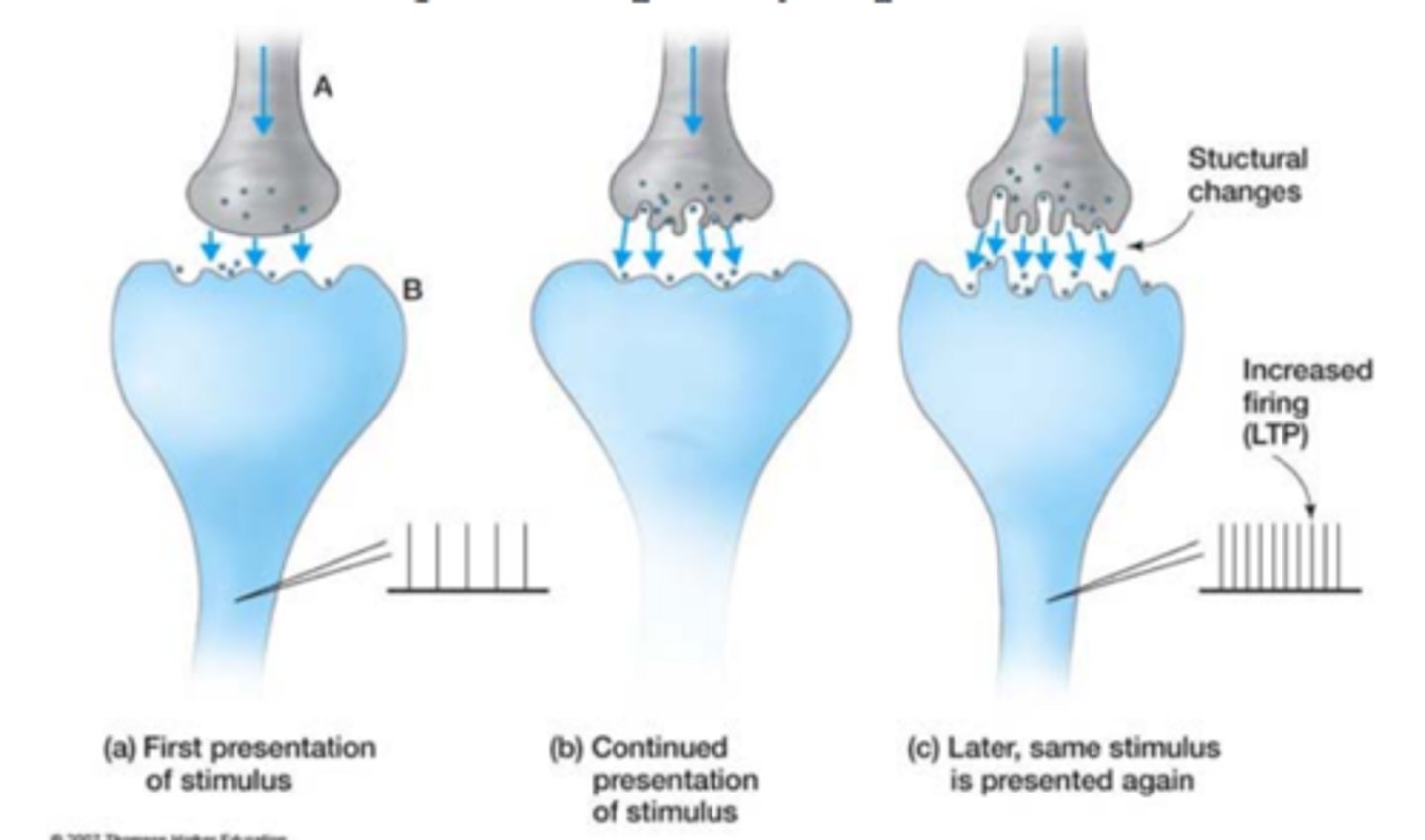
systemic consolidation
What it is:The gradual reorganization of memory across different brain regions.
Timescale:Occurs over days, weeks, months, or even years.
Where it happens:Transitions memory dependence from the hippocampus to the neocortex (especially in declarative memory).
Biological mechanisms:Involves repeated reactivation of memory traces (e.g., during sleep), allowing for integration into long-term storage in the cortex.
Purpose:Makes the memory more permanent and resilient to hippocampal damage over time.
When you first learn something, your brain's "memory helper" (the hippocampus) holds onto it, kind of like a backpack carrying new notes. Over time, your brain slowly moves the memory into the "big library" (the cortex), where it gets stored safely so you don't always need the backpack.
okay more permanent with experiences
long-term potentiation (LTP) – enhanced neural processing that results from the strengthening of synaptic connections.
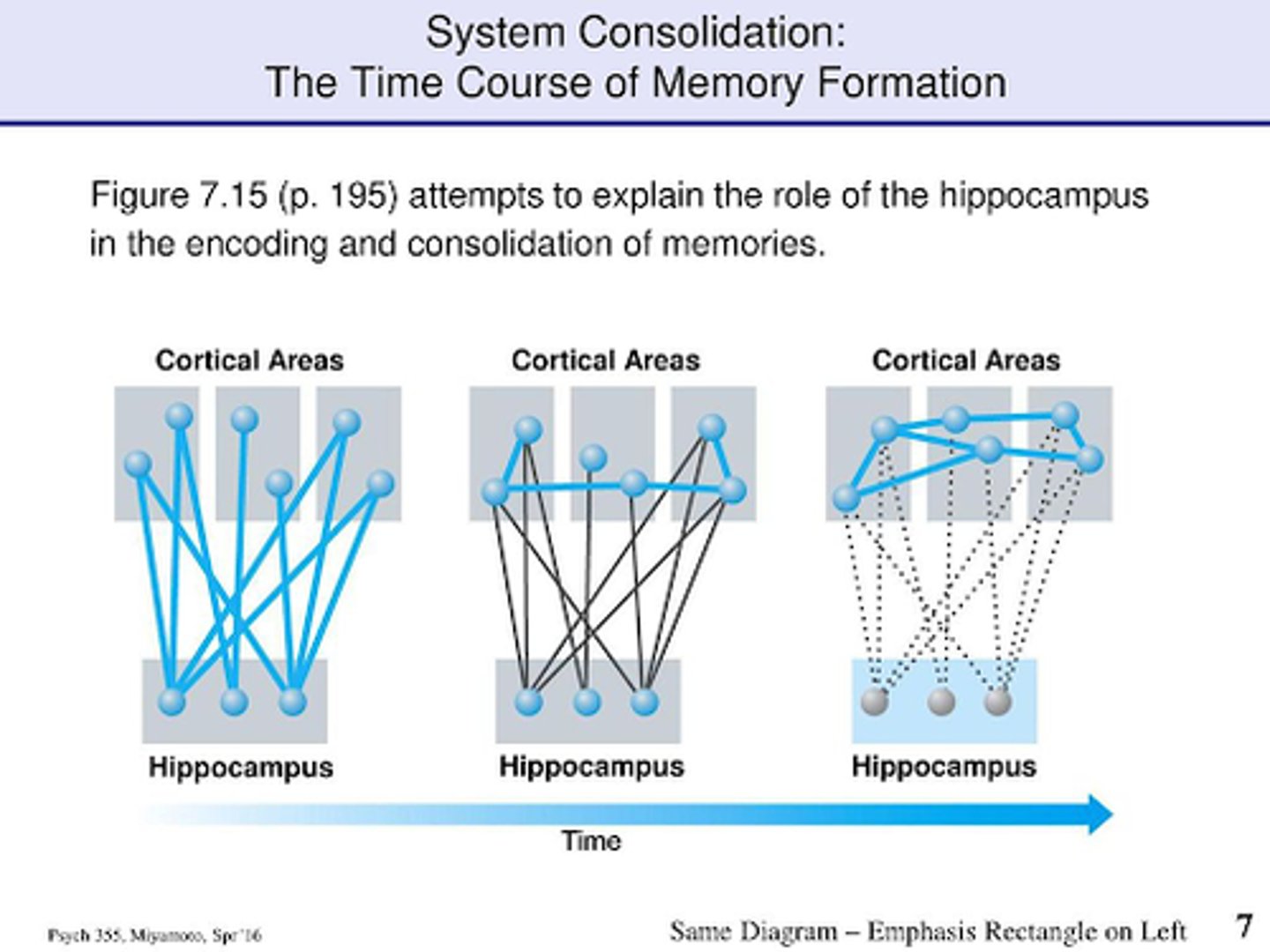
how do we organize memories/knowledge?
by cateogory!
ex. fruits, vegetables, and not all words starting in "P" thats why that is harder to think of
tip of the tongue
the feeling that a memory is available but not quite retrievable...sometimes people need a "cue"
cue for retrieval
sometimes you need a "cue" of a word, person, place, etc. for a memory to be retrieved
Because a person's physiological or psychological state at the time of encoding is associated with the information being encoded. If the person's state at the time of retrieval matches their state at the time of encoding, the state itself serves as a retrieval cue - a bridge that connects the moment at which we experience something to the moment at which we remember it.
or example, in one study, divers learned some words on land and some other words underwater; they recalled the words best when they were tested in the same dry or wet environment in which they had initially learned them because the environment itself served as a retrieval cue (Godden and Baddeley, 1975).
factors that influence the memory
1. context
2. When
3. Age
4. encoding (depth of processing)
5. existing knowledge structure
6. time since learned
7. retrieval practice
depth of processing
the idea that information that is thought about at a deeper level is better remembered
a theory with memory that the more you process/encode a memory the better it is engraved into you
ex. if you see a word and asked to rhyme it with something, what category it is, or use in a SENTENCE you will have better processed/encoding it putting it in a sentence and thus remember it better when asked what word you were given later
this works with drawings as well..
it is easier to remember a drawing with a description than a drawing by itself as it's more complex and thus better encoded
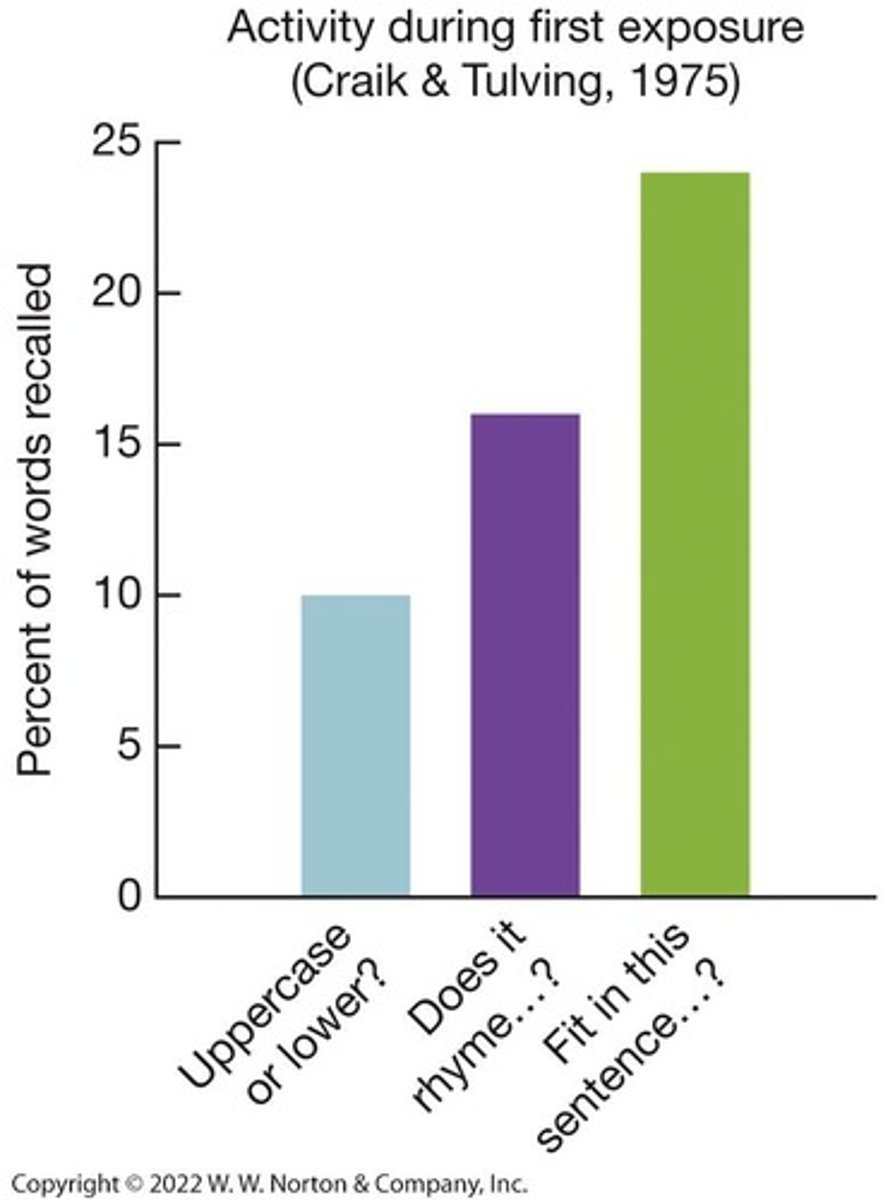
Existing Knowledge structures
our existing knowledge of something can interfere/distort our memory in order to make sense of something confusing
ex. when someone is reading a complex story and hears the words "gray smoke coming out of a guys mouth" most people will think of that person as coughing in their mind to make the most sense of it
mnemonic devices
techniques for using associations to memorize and retrieve information
examples include:
1. method of luci
2. pegword system
3. Verbal
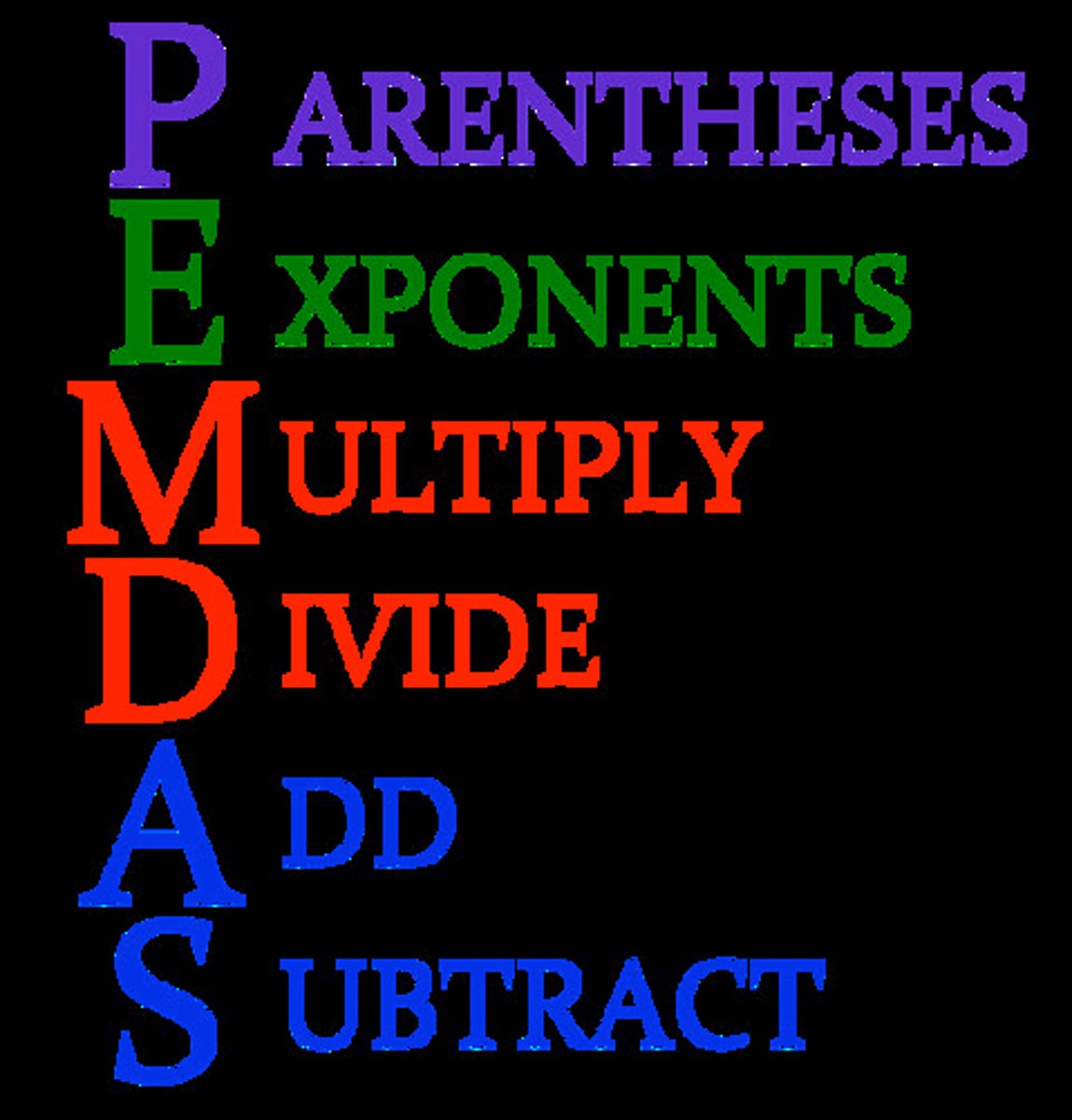
method of luci
Method of mnemonic strategy that is very visual. Dates back to ancient greece. Way of memorizing lists in which each item is tied with a bizarre image to keep it in the memory. Allows you to add meaning to something that previously had none, making it easier to remember.
an example of this is if you are going to the grocery store and need to remember something. Maybe go through a "house tour" in your mind and milk will be flooding the living room, and crackers will be the couches in order to remember what to get
pegword system
a memory technique in which to-be-remembered items are associated with pegwords, each of which rhymes with a different number between one and ten
rhyme words to help remember them
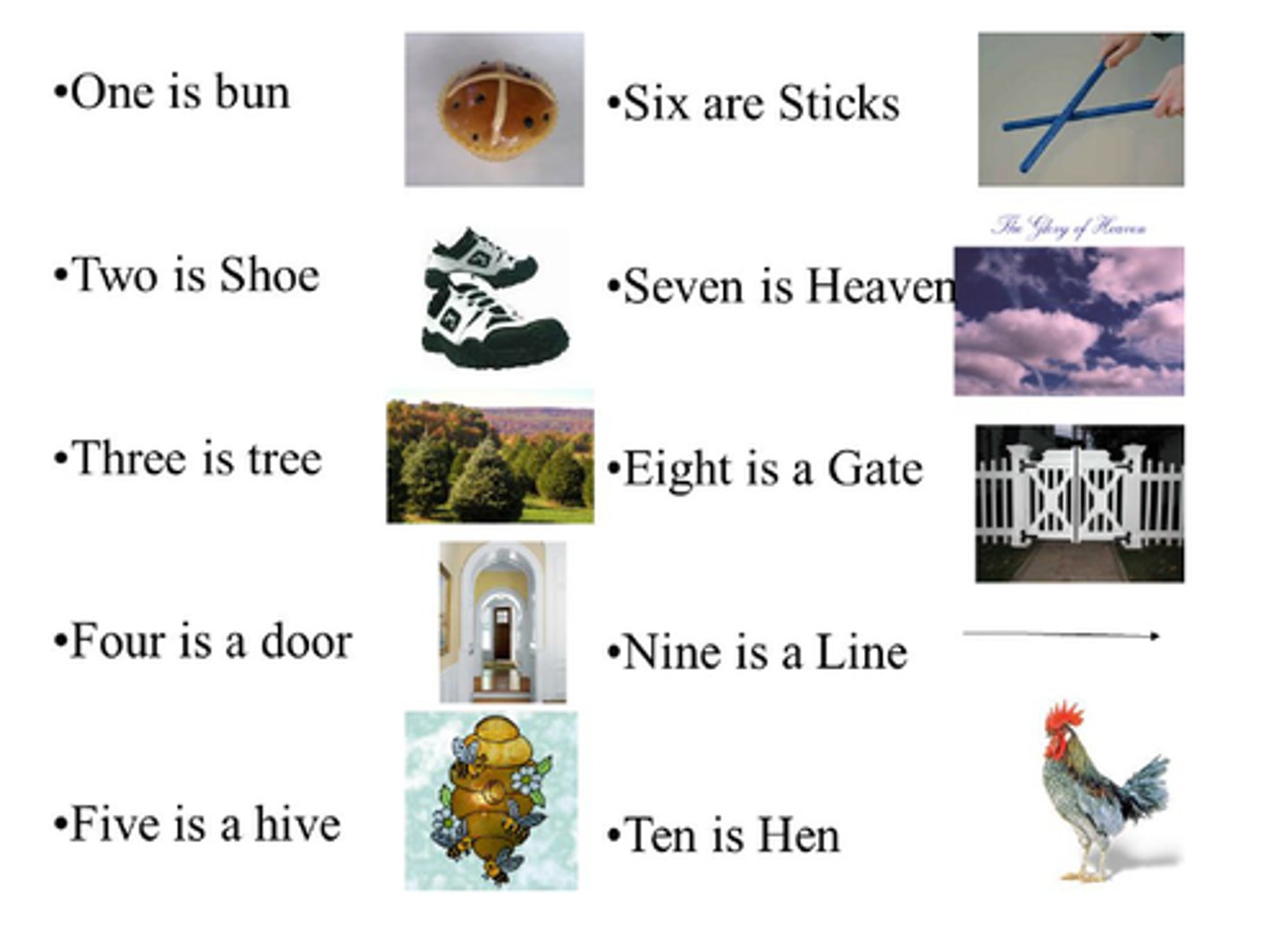
verbal
when you create a verbal thing to help you remember
ex. ROYGBIV for the colors of the rainbow
how questions can change memory
the way a question is asked to a person can change the way someone remembers/answers it
for example: when someone sees a video of a car crash and asked a question about how fast the car was doing (this is where they used different words) "collison", contact", etc.
people said different speeds based on the question asked.
context of a memory
memory has to do with context. When you are encoding information you are also encoding the settings/area around you.
example: people hear a word underwater and on land. if they are asked to repeat the word they hear they will better remember the word if they are asked in the area they heard it. This is why, if you can, study when you take a test
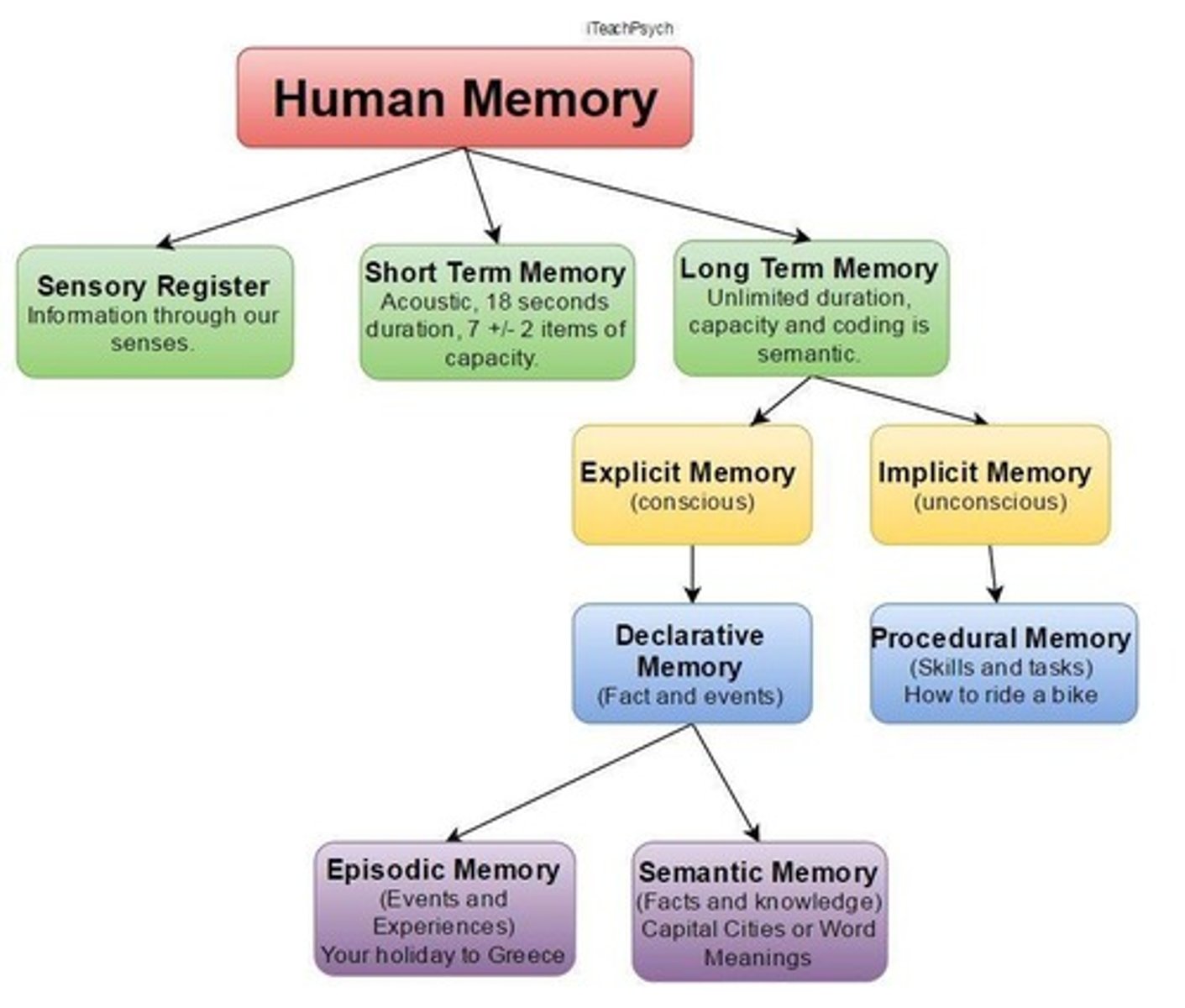
retrieval practice
enhances long-term retention by actively recalling information from memory
the repeated retrieval of an item of information from memory
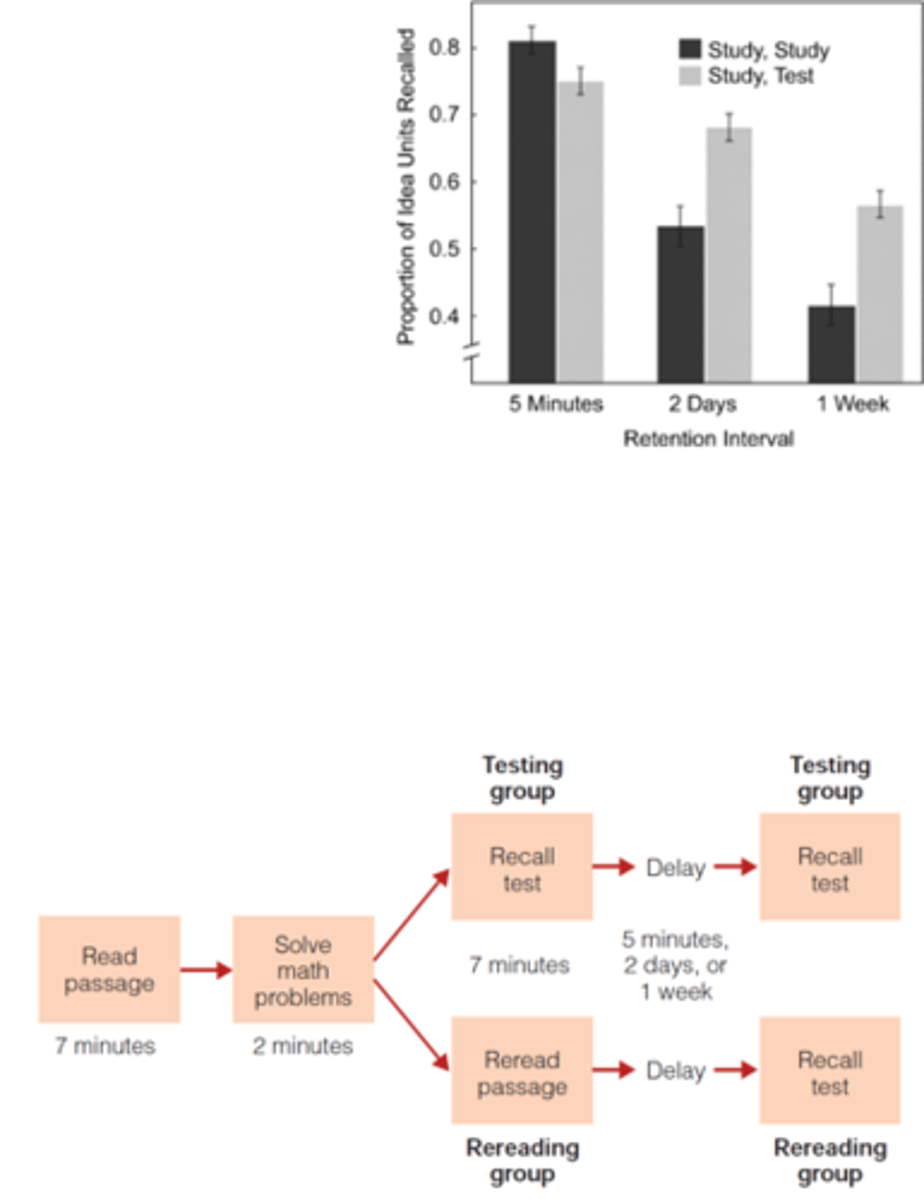
testing effect
enhanced memory after retrieving, rather than simply rereading, information
to better remember info it's better to test yourself instead of just reading it over again for the long-term as it helps retrieve that memory and further process it better to know for a test. THIS IS FOR THE LONG TERM. in the short-run if cramming better to just read over everything in case you see that word on a test its like a "cue"
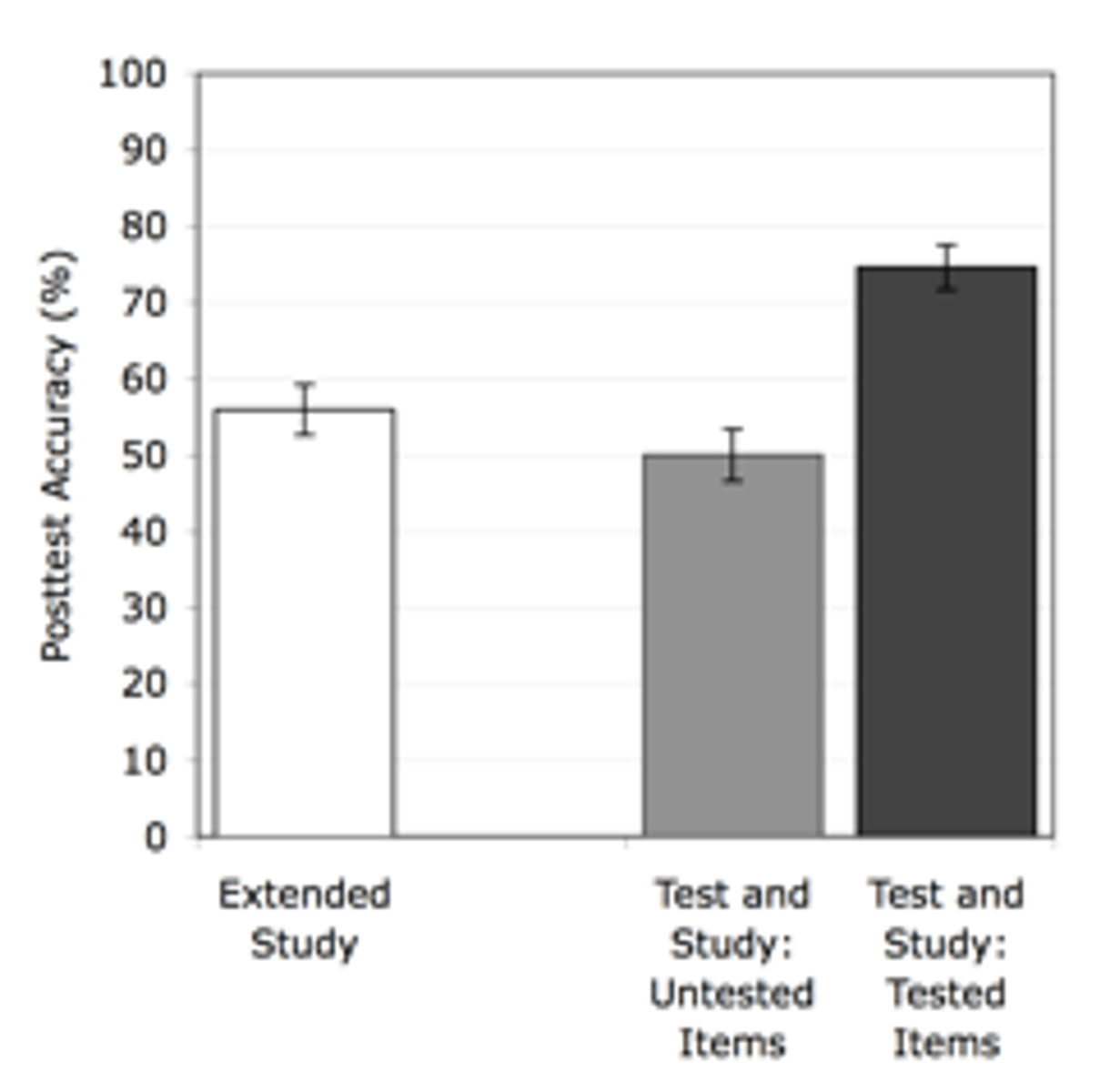
retrospective memory
as more time passes you tend to forget your long-term memory more and more as new memories comes to the mind. This happens with more meaningful and unmeaningful moments but more so with unmeaningful as there is not so much of an emotional connection - HAS TO DO WITH THE NEURON CONNECTION
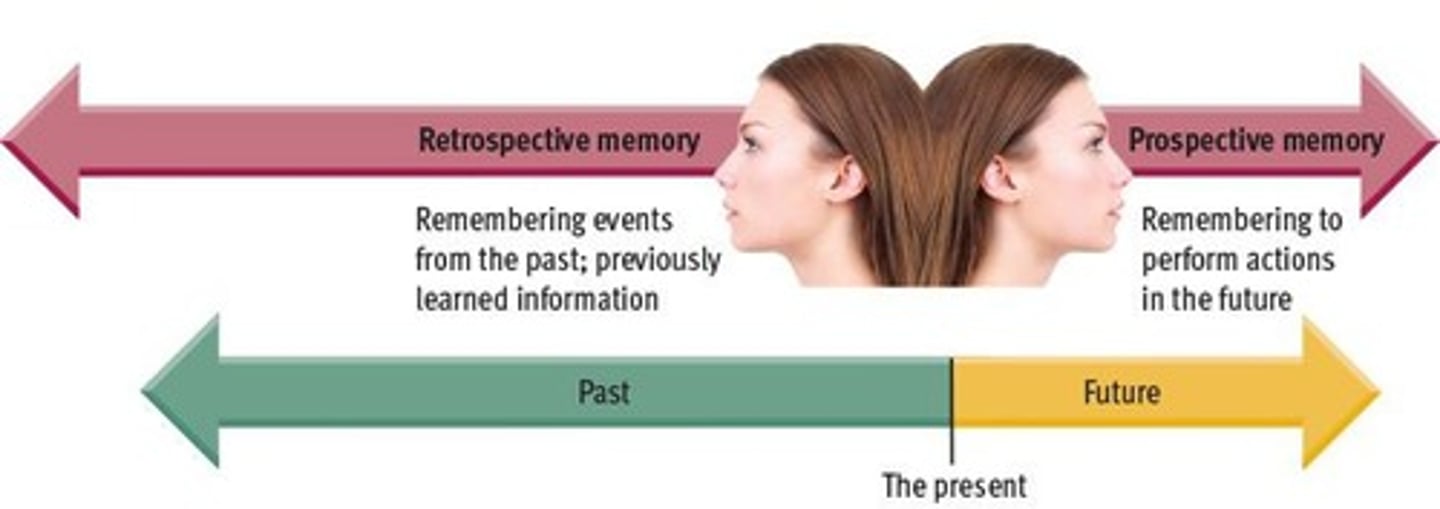
proactive memory
when you tend to forget new learning because of past learning. Older items affect new ones.
ex. you have a usual parking spot then one day its taken so might park somewhere else. If distracted or not thinking might just go to your usual spot instead of the new spot today
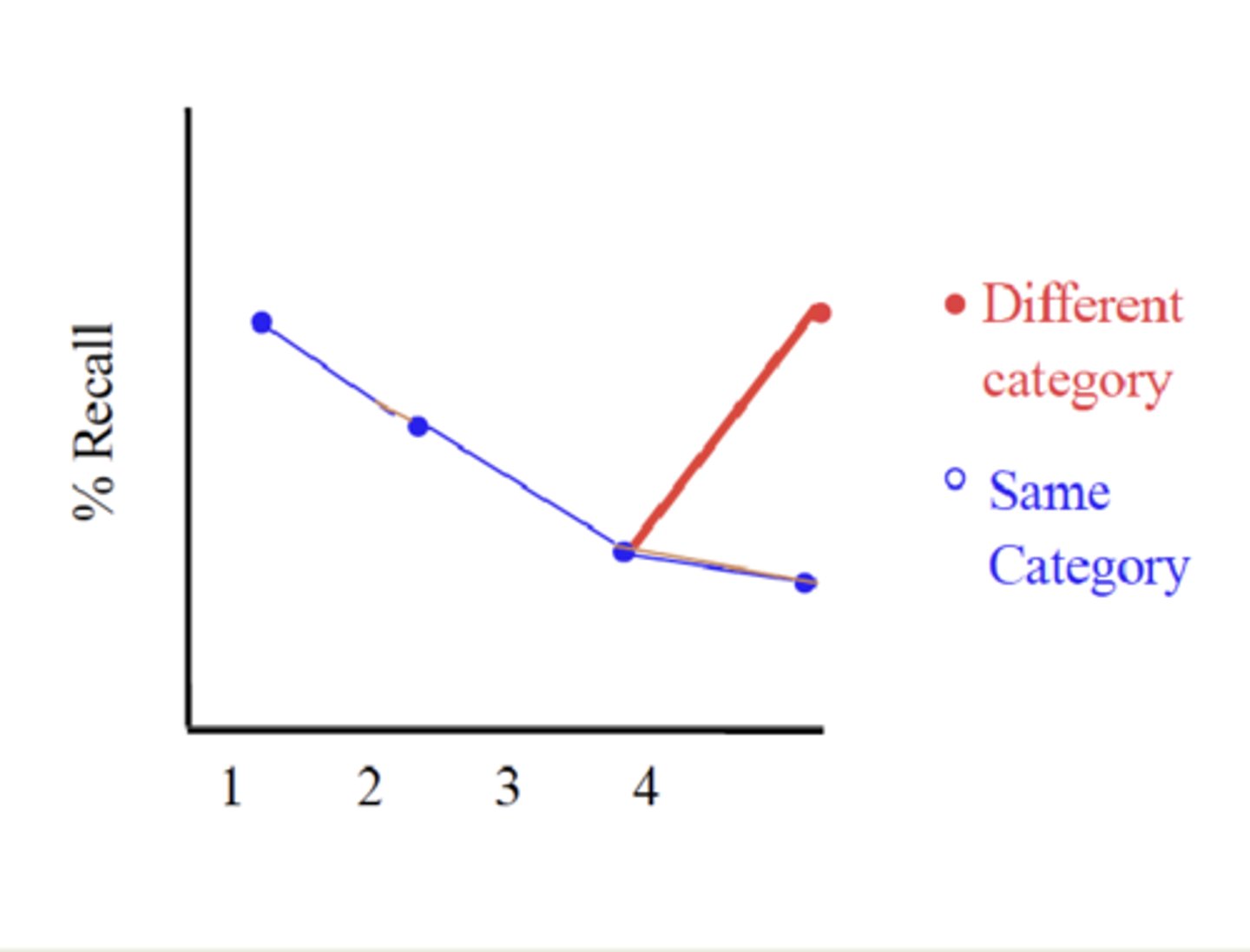
Age effect on memory
Depending on how old you are when a memory happens, can have a strong impact of your retrieval of the memory, how you remember it, etc.
Most people remember memories the most from their 20s - probably because of things like milestones, etc.
reminiscence bump
enhanced memory for adolescence and young adulthood found in people over 40...theories are it has to do with sense of self and emotions
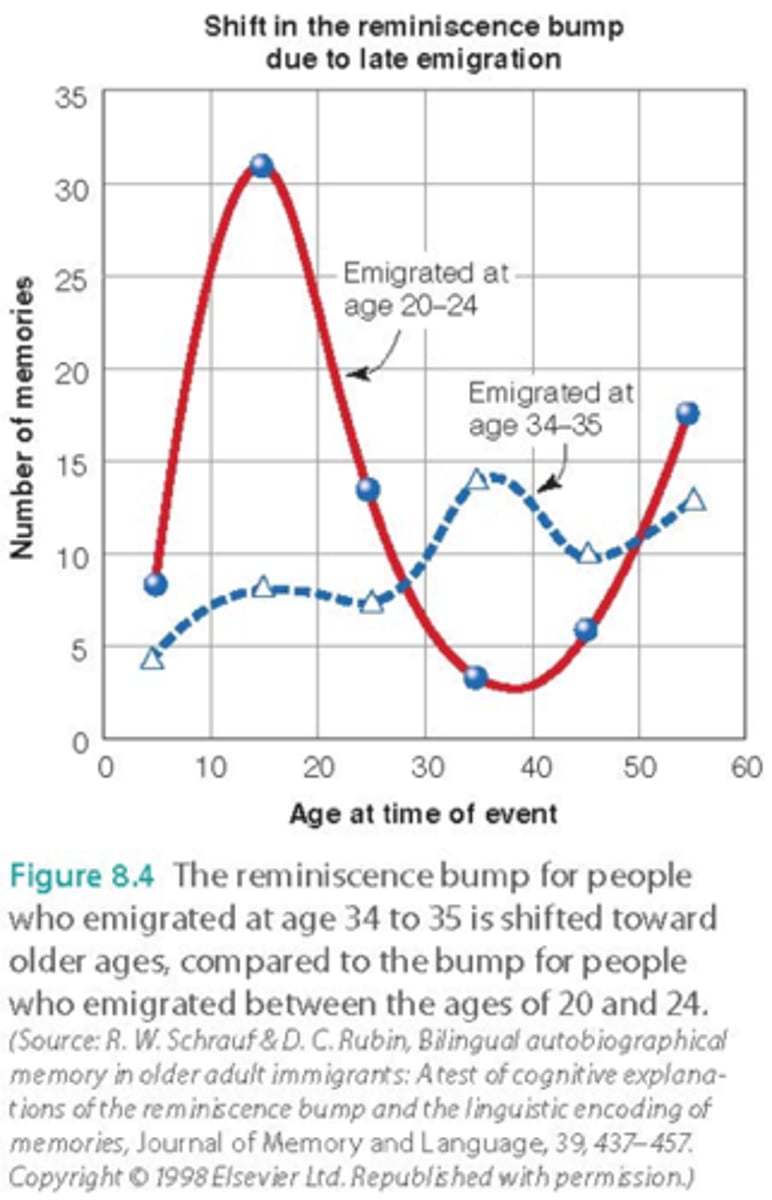
infantile amnesia
the inability to remember memories from roughly the ages from 0 to 5.
There have been many theories as to why - one has to do with too complex for the brains that are not fully developed,
flashbulb memories
people vividly remember the context in which they heard something
ex. princess diana's death - lots of people can tell you where they were when it happened

interference
drop in accurcracy of memory or doing something when trying to do more than one thing at a time
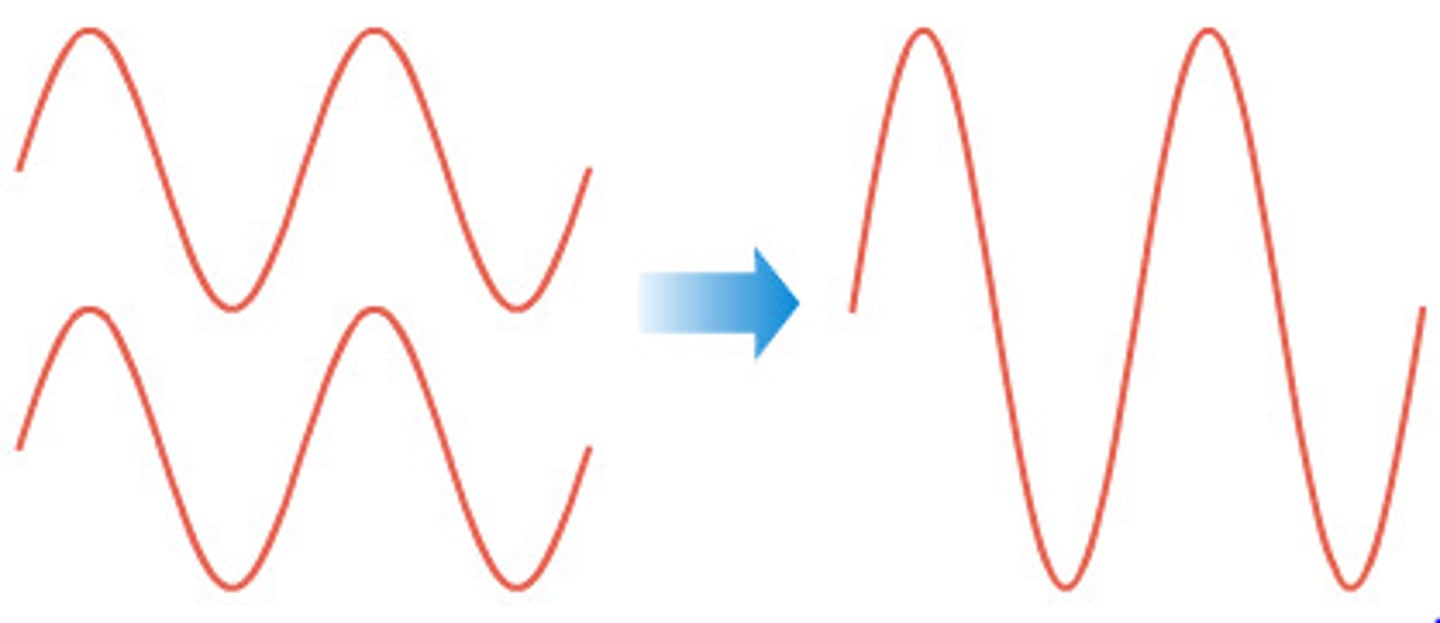
elaborative encoding
the process of actively relating new information to knowledge that is already in memory
this is one of the reasons why memory is NOT photographic or perfect but skewed
schemas - mental models of the world that contain knowledge that helps us to encode new information into a meaningful context
hippocampus
where new long-term memories are MADE but NOT stored.
if you recall a memory over and over again than you can tie the neurons better connected without the hippocampus
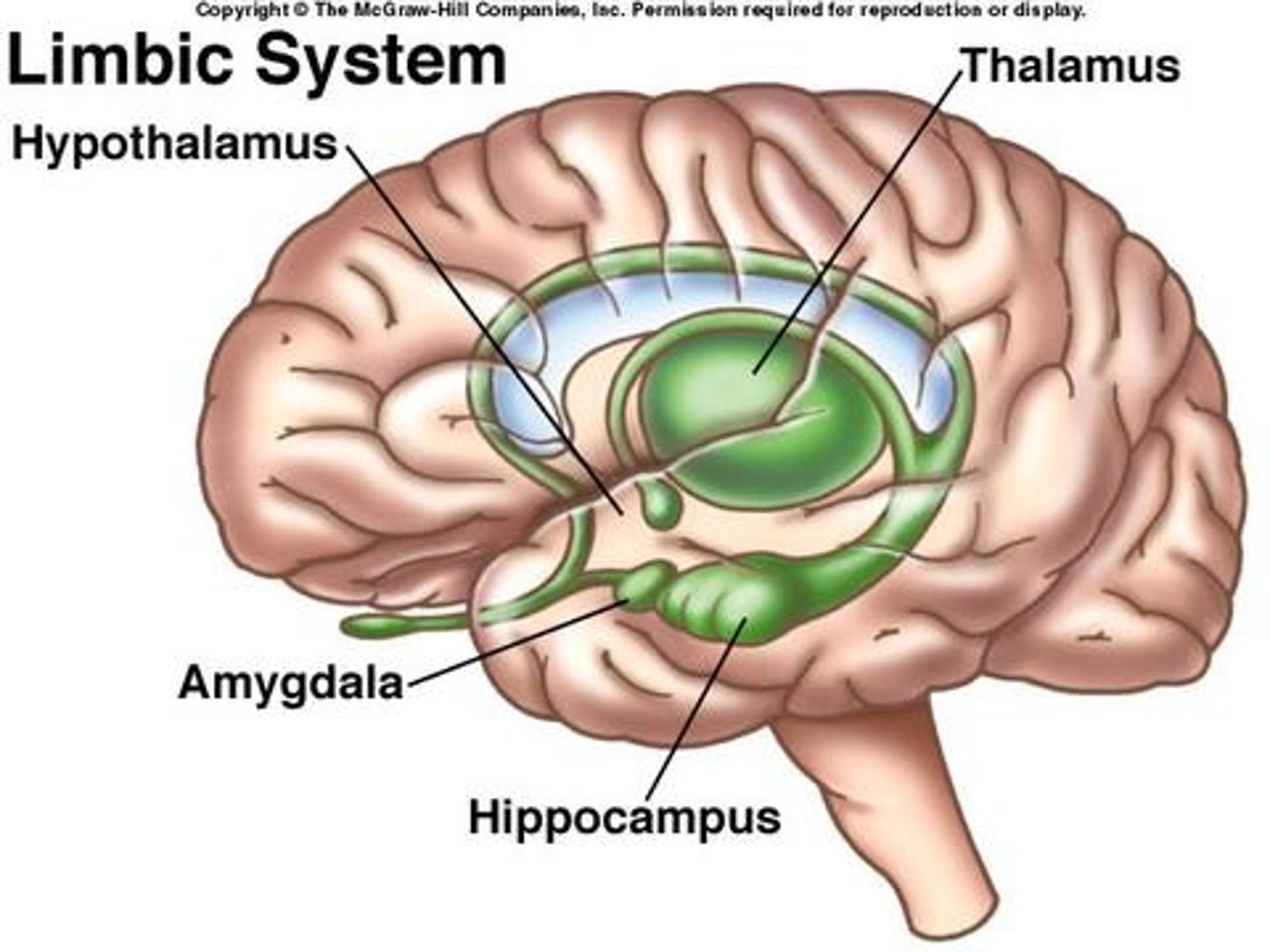
synapse
A junction where information is transmitted from one neuron to the next. This is where memories are thought to be held.
retrieval cue
a stimulus that helps us remembering something. Maybe a word, place, thing, etc.
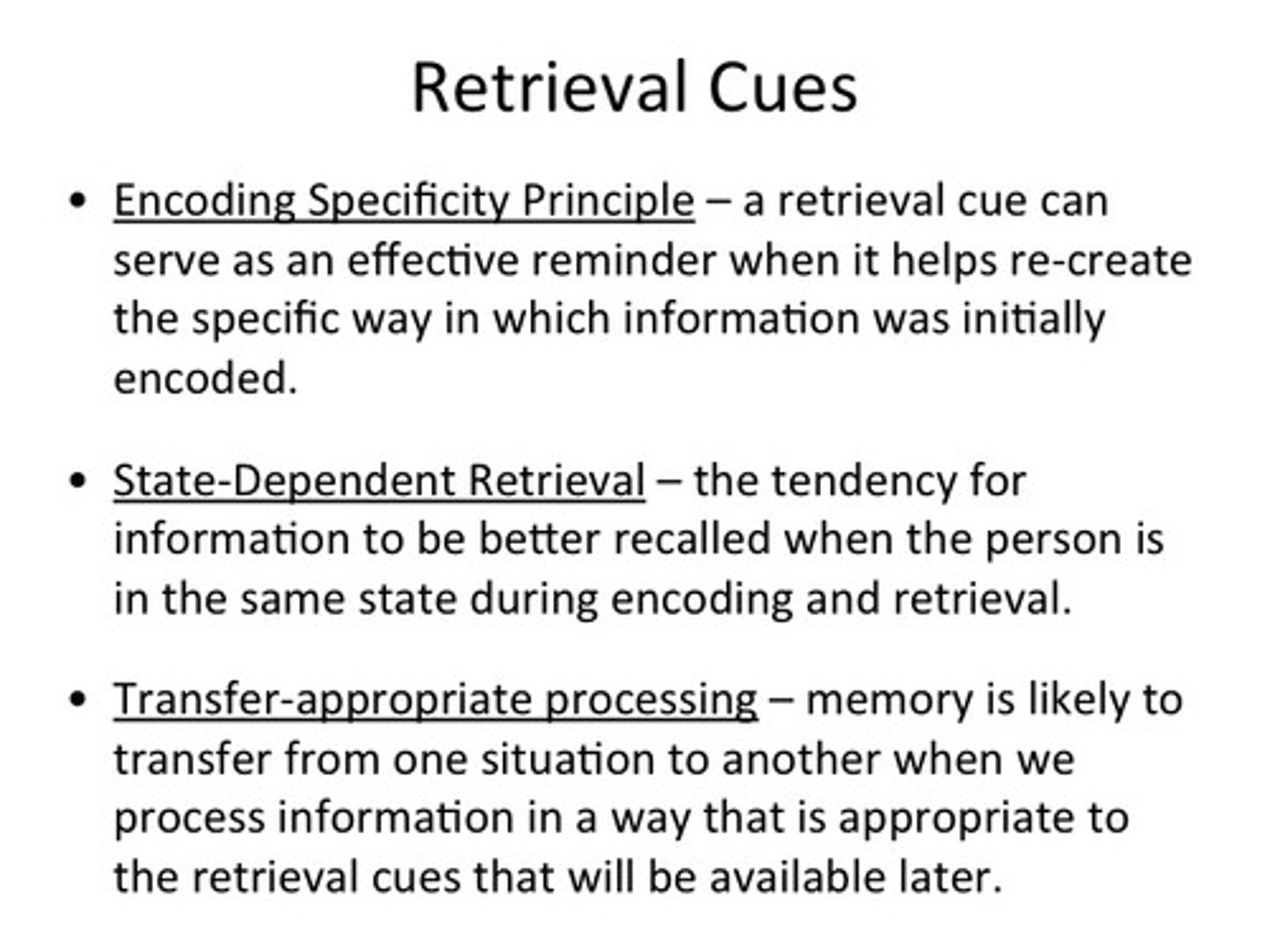
trying to remember vs actually remembering
these two things happen in different parts of the brain.
actually remembering happens in the hippocampus while trying to remember happens in the frontal lobe
transcience
forgetting what occurs with the passage of time
This process of forgetting appears to be gradual as time passes and more and more detail is lost - as if information seems to fade away with time.
rehearsal
the conscious repetition of information, either to maintain it in consciousness or to encode it for storage. usually repeat it over and over again in your head
short term memory
absentmindedness
a lapse in attention that results in memory failure
when your attention is divided it causes one to not properly//deeply encode
persistence
the intrusive recollection of events that we wish we could forget
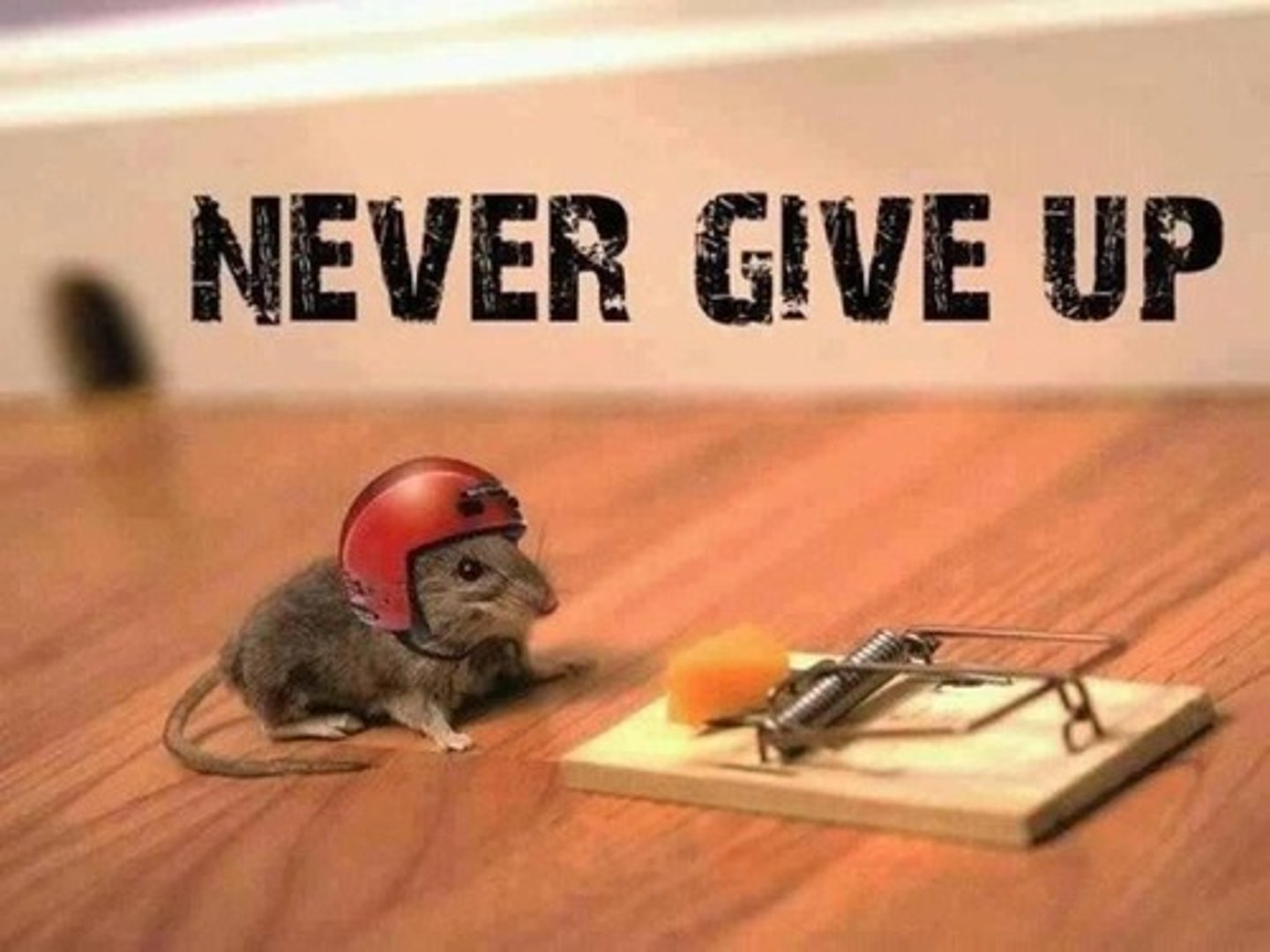
biases
distorting influences of present knowledge, beliefs, and feelings on recollections of previous experiences
ex. ecogentric, etc.
pscyhanetrics
the science of measuring mental capacities and processes.
individual differences approach, the assessment and evaluation of individual psychological abilities
galton
1st to suggest intelligence was inherited. Intelligence based on muscle strength, size of head, reaction time, etc.
This is because Galton contributed to so many areas of science. In his early career, he was a medical student, an African explorer, a travel writer and an influential and leading geographer.
charles spearman and two-factor theory of intelligence
creator of "g-factor", or general intelligence, concept and specific factors (f) - thought this because kids that tested good on one subject tend to do good on another
every task requires a combination of a general ability (g) and skills that are specific to the task (s) and shared with no other
ex.
G (general intelligence)
underneath have group factors (ex. memory)
underneath that cateogory have specific factors (ex. recalling movie titles)
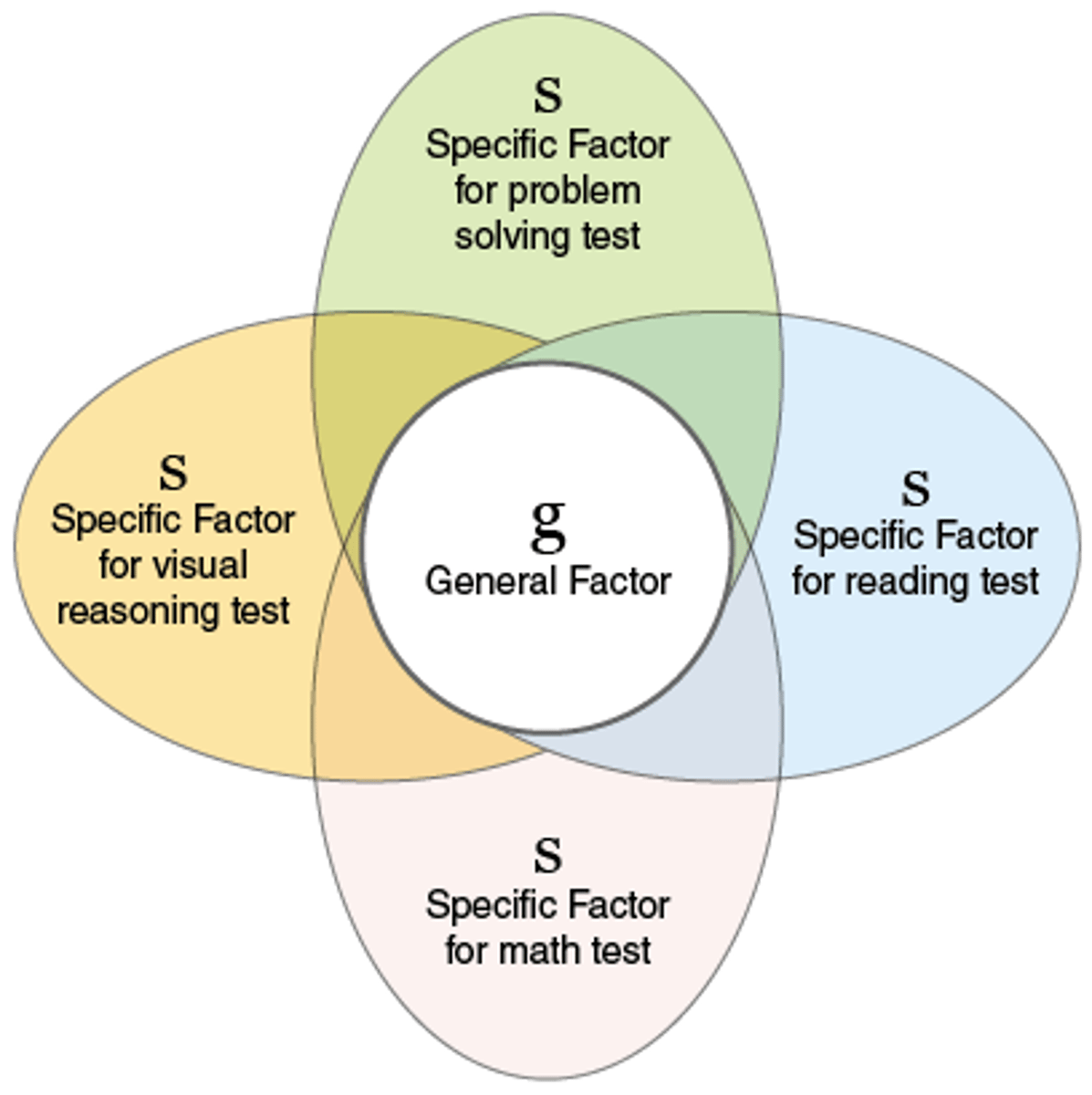
general intelligence
a general intelligence factor that, according to Spearman and others, underlies specific mental abilities and is therefore measured by every task on an intelligence test
underlying factor of intelligence
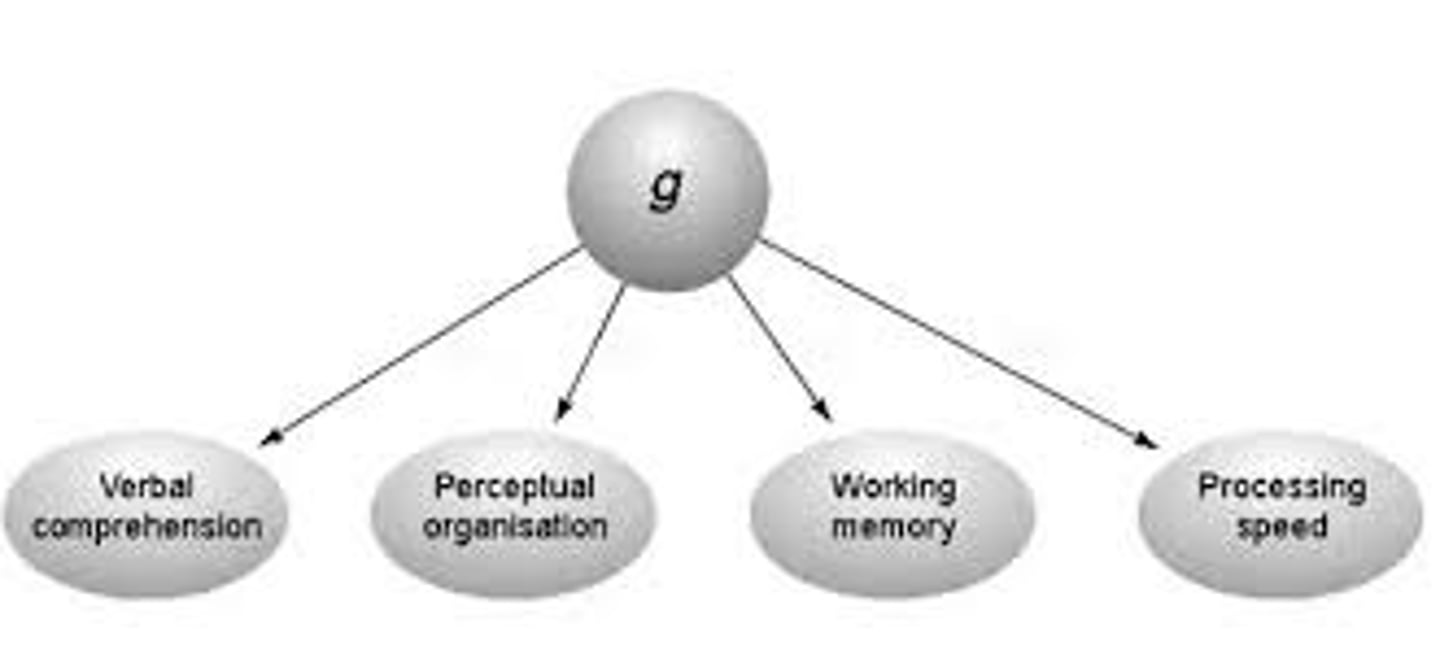
factor analysis
statiscal techinque that explores a large number of correlations in terms of small number of underlying factors
this would the g factor which effects the specific factors. Concluded there must be a general intelligence factor — called g — underlying all cognitive abilities. In the context of intelligence, factor analysis helps psychologists determine whether intelligence is a single ability (like general intelligence or g) or made up of multiple distinct abilities (like verbal, spatial, or logical skills).
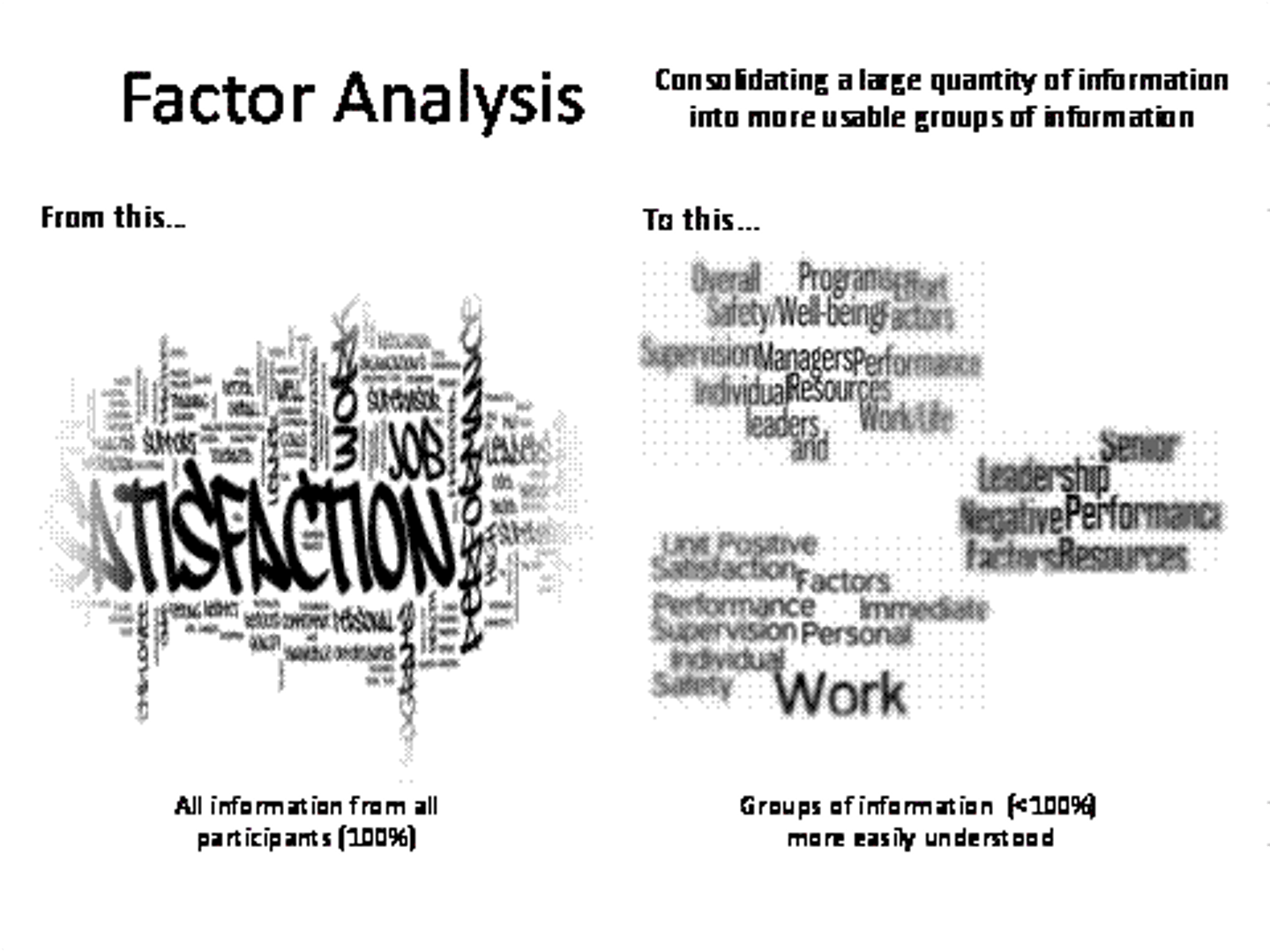
Alfred Binet and Theodore Simon
they created the first intelligence test. It was suppose to just expose natural intelligence that wasn't affected by education. This was suppose to be for kids
ex. seeing faces and saying which one is the most attractive out of those faces
NOTE: in other words, intelligence tests do not 'measure' intelligence in the same way that thermometers measure temperature. Rather, they measure the ability to answer questions and perform tasks that are highly correlated with the ability to get good grades, solve real-world problems and so on.
use the simon-binet test today
natural intelligence
The aptitude for learning independent of the child's prior educational achievement.
aptitude
Capacity for learning; natural ability
wechsler test and the deviation IQ
this intelligence test is preferred in the US. IQ scores based on individual deviation IQ scores rather than a ratio. These tests are designed for specific age groups and can be administered individually.
how to do it: compare ones score to the average in their age group
DEVATION IQ
Deviation IQ is a way of measuring a person's intelligence by comparing their performance on an IQ test to the average performance of others in their age group. It expresses how much a person's score deviates from the average (mean) IQ score.
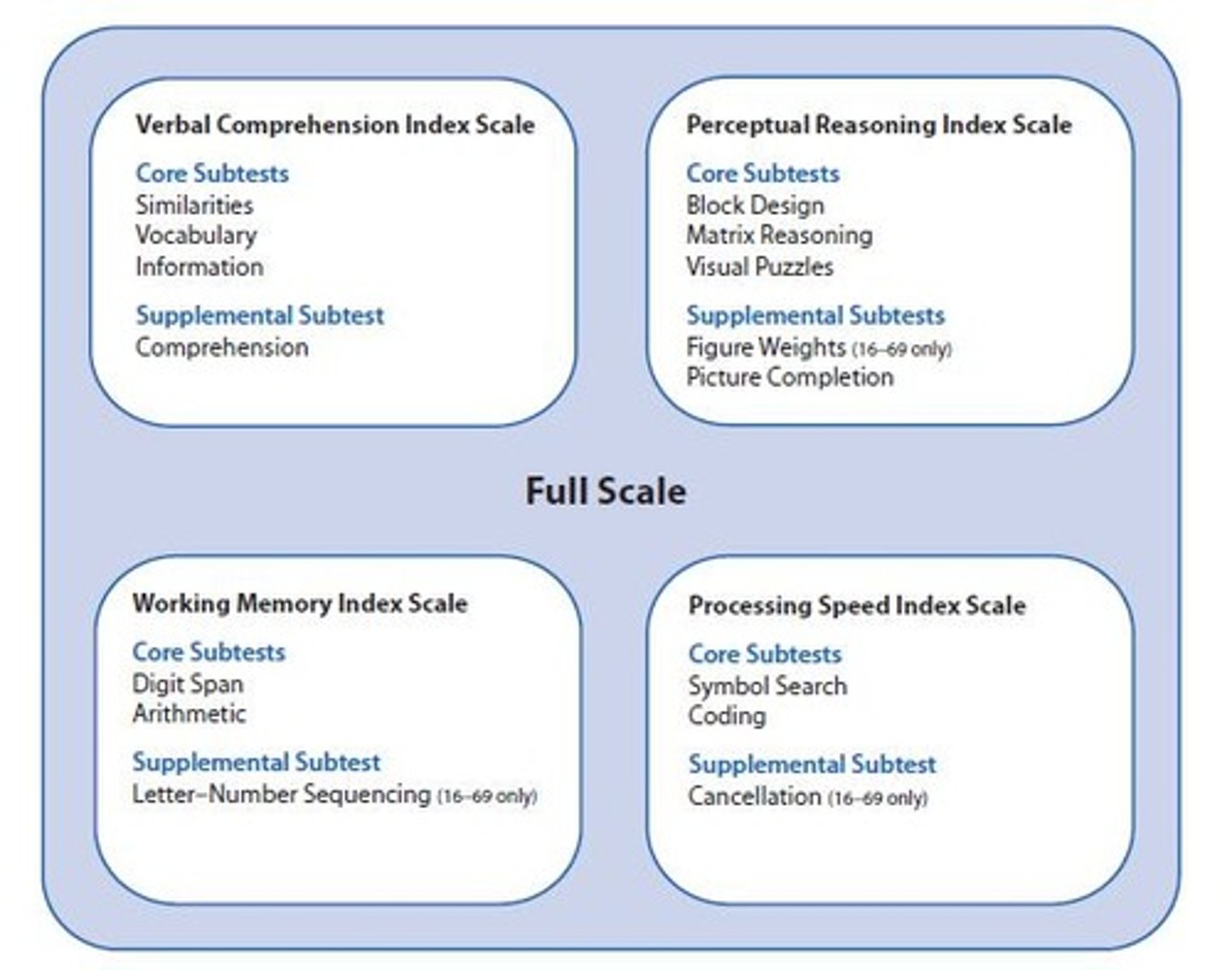
Psychometric test
exam to measure scientifically a person's mental capacities and personality
ex.
Psychometric intelligence tests
they show how someone will perform in work, how much education they will recieve, etc.
William stern ratio IQ
created the ratio IQ to take from intelligence tests. This can be used for kids only
formula: mental (age/chronological age)x100
NOTE: intelligence tests don't have to just be for apitude but now can be for knowledge, personality, etc.
Robert yerkes
president of the APA
created beta test (cannot read) and alpha test (could read) for WW1 soliders then brought to rest of the world
created prejudice as the tests were not about NATURAL INTELLIGENCE but KNOWLEDGE (ex. capital of Mass) spreading racism and anit-immigration across America
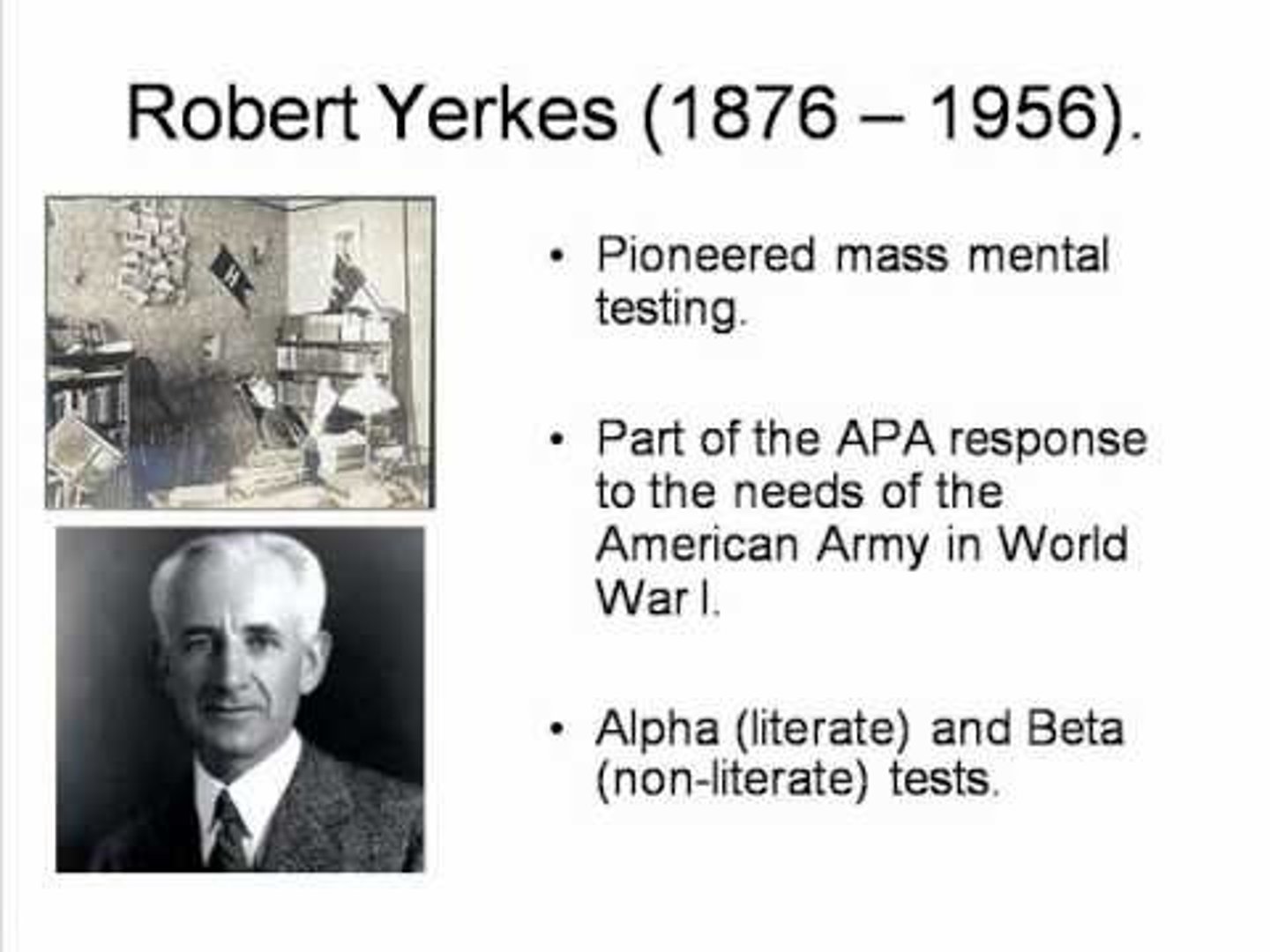
epidemiology and intelligence
Branch of medical science concerned with the incidence, distribution, and control of diseases that affect large numbers of people.
it is said that people with more intelligence (crystallized and liquid) less likely to disease. This probably has to do with better nutrition, education, etc.
(ex. person with less health education more likely to smoke and more likely to get lung cancer)
Low-SES children have poorer nutrition and medical care, they experience greater daily stress and they are more likely to be exposed to environmental toxins such as air pollution and lead - all of which can impair brain development (Ash and Boyce, 2018; Chen et al., 2010; Evans, 2006; Hackman and Farah, 2008
higher intelligent people have...
1. more patience
2. shorter reaction time (hick's law)
3. less disease
3. more education
4. perform better in the work place
5. recieve higher salaries (good measure of ability to perform and thus do better in the work area as have more critical thinking skills)
Louis Leon Thurstone
Contributed to development of factor analysis. He argued against the single G-Factor and instead claimed that there was a cluster of distinct abilities which influenced the performance of individuals on tests
he believed in independent mental abilities like verbal, perpceptual, and numerical
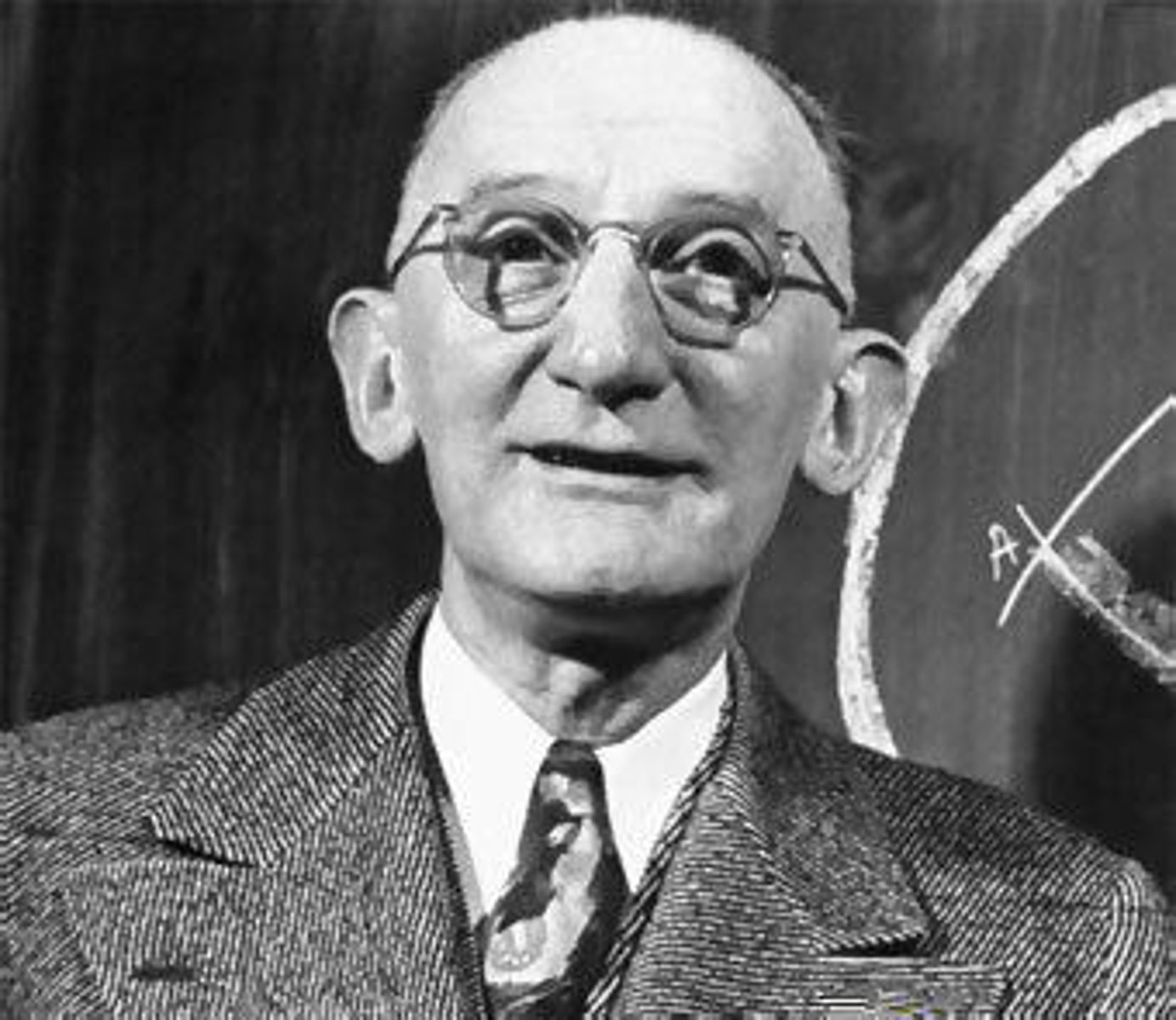
Thurstone and Spearsman combined
factor anaylsis proved both are right
there are 3 levels of hierarchy
1. general factors (general intelligence)
2. Group factors
3. Specific factors
group factors of intelligence
memory and learning, visual perception, auditory perception, retrieval ability, cognitive speediness, processing speed, crystallized intelligence, and fluid intelligence
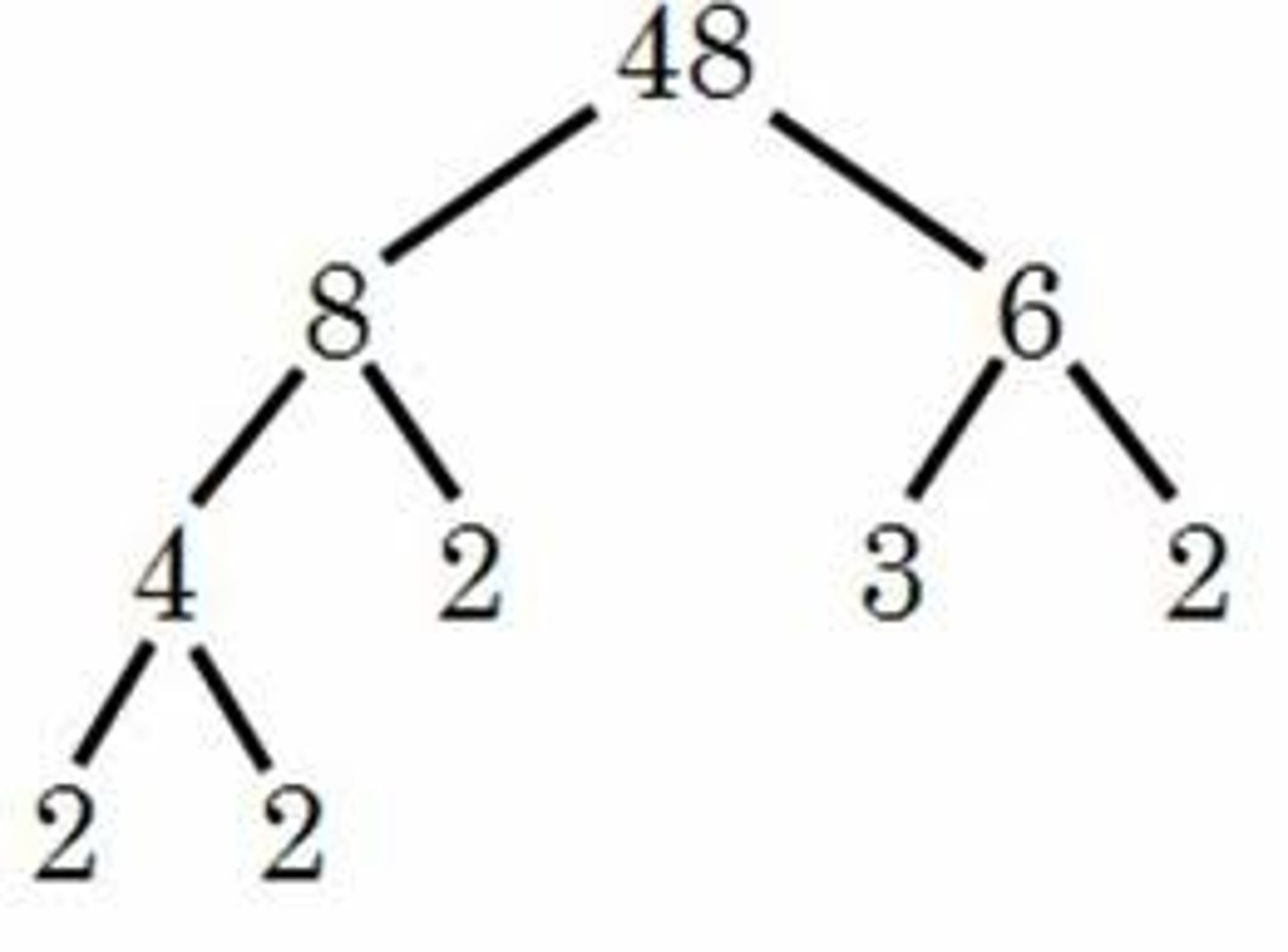
fluid intelligence
ability to see complex relationships and solve problems
one's ability to reason speedily and abstractly; tends to decrease during late adulthood
this sadly cannot really change (by increasing) overtime
relative intelligence
reason why children who scored high on IQ tests when they were younger, also score higher than other individusl older in life
comtinues to develop greater by generations as in our daily lives, espically with tech, we have to solve complex relationships and problems.
crystallized intelligence
our accumulated knowledge and verbal skills; tends to increase with age
since this is based on KNOWLEDGE can def be expanded
absolute intelligence
top down approach intelligence
The top-down approach to intelligence refers to a framework where high-level cognitive functions guide or influence lower-level processes. This is often contrasted with the bottom-up approach, where intelligence is thought to emerge from simple sensory or neural mechanisms building up to complex cognition.
A top-down approach starts with big-picture goals and breaks them into smaller parts, while a bottom-up approach begins with details and builds them into a comprehensive plan or solution

bottom up approach intelligence
Using intelligence questionnaires data tofind different 'middle-level' abilities.◦ Fails to find abilities that are not askedabout in intelligence tests (i.e. creativity)
tarting with people's responses on intelligence tests and then looking to see what kinds of independent clusters these responses form
ex. This pattern suggests that a person who can swat flies well can also balance teacups well, and that a person who can understand Shakespeare well can also add up numbers well, but that a person who can swat flies well and balance teacups well may or may not be able to add up numbers or understand Shakespeare well. From this pattern, we could conclude that there are two middle-level abilities (shown in Figure 9.7b), which we might call 'physical coordination', the ability that allows people to swat flies and balance teacups well, and 'academic skill', the ability that allows people to understand Shakespeare and add up numbers well.
BAS: cannot discover any middle level abilities test fails to measure
prodigy
A person with great talent; a young genius
usually people with this kind of intelligence their intelligence is focused on one specific area (ex. mathematics or music)
howard gardner
devised theory of multiple intelligences: logical-mathematic, spatial, bodily-kinesthetic, intrapersonal, linguistic, musical, interpersonal, naturalistic
other ones the textbook add is creativity
created independent factors
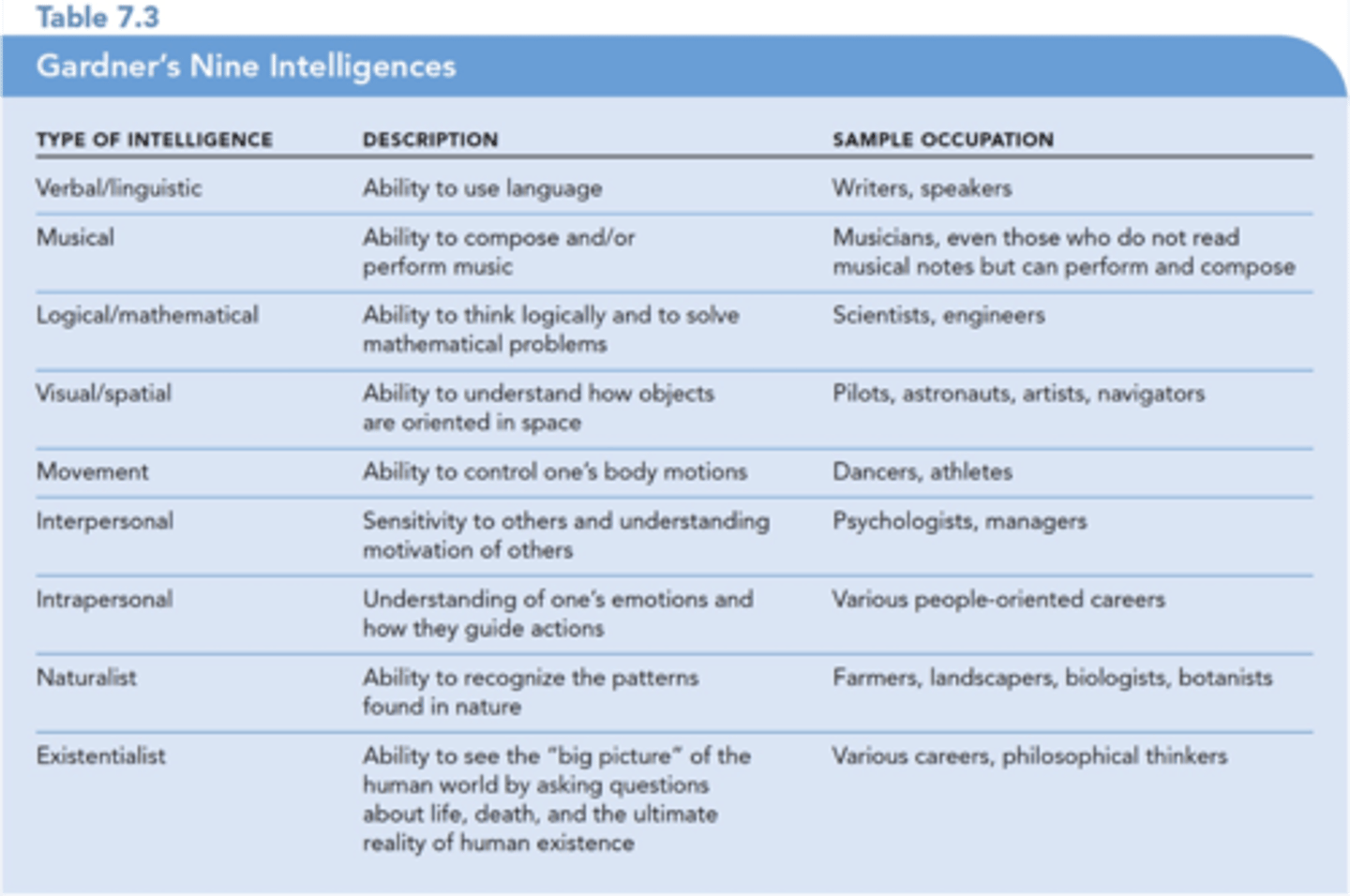
emotional intelligence
Emotional Intelligence (EI or EQ) is the ability to recognize, understand, manage, and influence emotions—both your own and others'. It plays a key role in how people interact, build relationships, make decisions, and handle social complexitie
THIS HAS TO DO WITH INTERPERSONAL AND INTRAPERSONAL INTELLIGENCE
breakdown of where intelligence comes from
50% - genes (identical kids who live apart more similar intelligence than fraternal that live together)
50% environment (unrelated siblings who live together more similar intelligence related siblings that live apart)
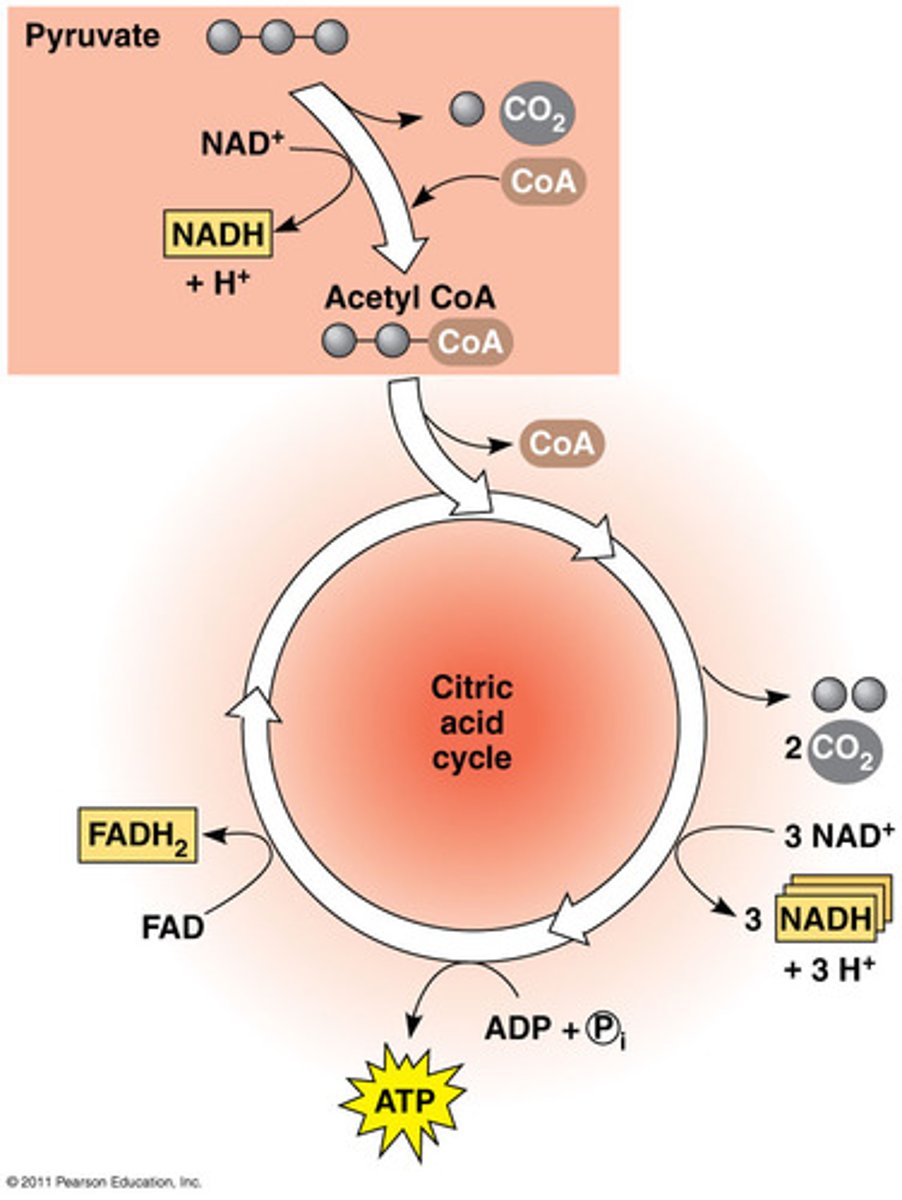
heritability coefficient
a statistic that describes the proportion of the difference between people's scores that can be explained by differences in their genes
.1= low genetic similarity
.9 = high genetic similarity
The heritability coefficient tells us why people in a particular group differ from one another; thus, its value can change depending on the particular group of people we measure
NOT BY ONE SINGLE PERSON BUT A WHOLE GROUP COMPARISON AS CANNOT TELL FOR JUST ONE SINGLE PERSON IF MORE GENE OR ENVIRONMENT
Stereotype threat
the fear of confriming the negative beliefs that others may hold. If students asked their nice before a test (e.g hispanic children) might be scared of the stereotypes associated with their race and do worse
what this shows: is that different group experiences definitley play a role in intelligence tests of different groups yet not so much reasearch on genetics part
flynn effect
The rise in average IQ scores that has occurred over the decades in many nations
as time goes on generations tend to be smarter than the last. This is the fluid intelligence (relative intelligence) due to higher stimulation of the world around us, no lead in gasoline, better nutrition/hygiene
personality
an individual's characteristic style of behaving, thinking, and feeling
set of behaviours, cognitions, emotional patterns that are biological + environmental formed and change over time
personality is in the eye of the beholder
four main approaches to understanding personality - trait, psychodynamic, humanistic-existential and social cognitive.
ur personalities are determined by the forces in our minds, by our personal history of heredity and environment, and by the choices we make and the goals we seek

psychodynamic
how behavior springs from unconscious drives and conflicts
social cognitive approach
a psychological theory that explains how people learn behaviors, develop beliefs, and form attitudes by observing others and interacting with their environment.
what is personality shaped by?
genetics (depending on the trait - some more than others), parents, peers, birth order, and culture (aka environment - yet very little)
the Trait approach
The trait approach to personality uses such trait terms to characterise differences among individuals.
Allport (1937) saw traits as pre-existing dispositions, causes of behaviour that reliably trigger the behaviour. The person's orderliness, for example, is an inner property of the person that will cause the person to straighten things up and be tidy in a wide array of situations.
what they both did (in their own languages) was go through the dictionary and find words that related to personality
they cateogorized the traits in two ways...
1. orthogonal factors
2. oblique factors
lexical and Alport/Obert
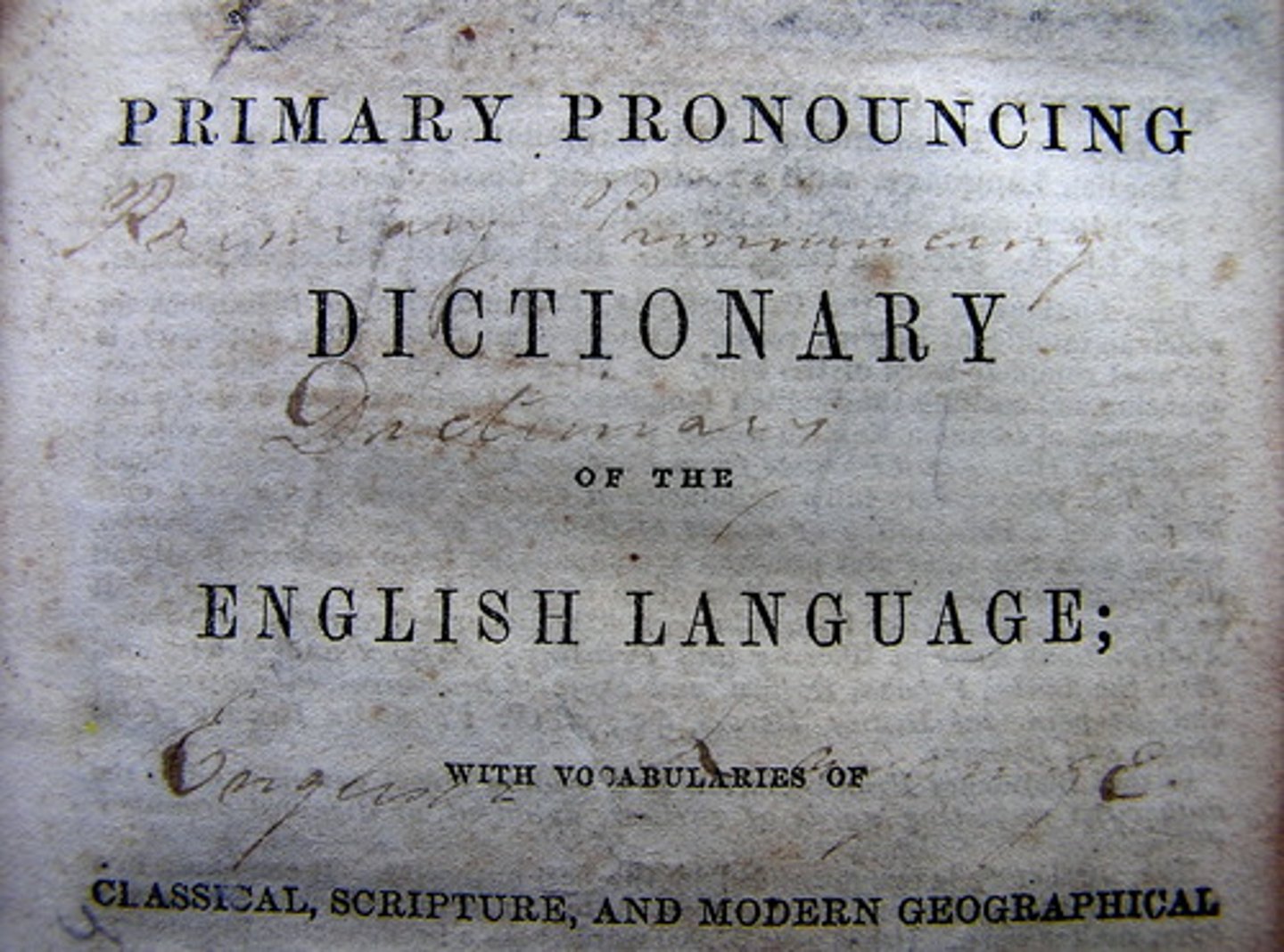
trait
A trait is a relatively stable disposition to behave in a particular and consistent way
Theophrastus
first theorists of personality in book "the characters"